

Zitierweise / cite as:
Payer, Alois <1944 - >: Chronik Thailands = กาลานุกรมสยามประเทศไทย. -- Wirtschaft Siams um 1908. -- Fassung vom 2013-10-05. -- URL: http://www.payer.de/thailandchronik/chronik1908c.htm
Erstmals publiziert: 2013-10-05
Überarbeitungen:
©opyright: Dieser Text steht der Allgemeinheit zur Verfügung. Eine Verwertung in Publikationen, die über übliche Zitate hinausgeht, bedarf der ausdrücklichen Genehmigung des Herausgebers.
Dieser Text ist Teil der Abteilung
Thailand von
Tüpfli's Global Village Library
ช้างตายทั้งตัวเอาใบบัวปิดไม่มิด
|
Gewidmet meiner lieben Frau Margarete Payer die seit unserem ersten Besuch in Thailand 1974 mit mir die Liebe zu den und die Sorge um die Bewohner Thailands teilt. |
"In recent years Siam has rejoiced in the happiness which proverbially attaches to the country which has no history—no stirring history. Her record has been one of uninterrupted commercial prosperity and peaceful and progressive development. With her independence guaranteed by the Franco-British agreement, her rulers have been able to devote their energies to the consolidation of the nation's influence within the limits assigned by that instrument, and foreign capital has found in the country a safe and increasingly lucrative sphere for investment.
The beneficial effects of the new regime are clearly revealed in the growing trade of the country. The following table shows the position as disclosed in the most recent official reports.
Imports and Exports. £
1902 7,927,646 1903 7,431,237 1904 10,014,141 1905 9,982,735 1906 11 ,948,990 These are remarkable figures, and tell a story of stable trade and increasing prosperity such as few of the smaller Asiatic countries can show.
One factor which has contributed very largely to the growth of commerce is the immense development of rice cultivation which has taken place in recent years under the fostering care of the Government. In 1904 the total value of the cereal exported considerably exceeded the value of the entire trade of the country ten years earlier. In 1906 rice accounted for 78 per cent, of the total exports. Thus it may be said to have attained to a predominant position amongst the industries of Siam. But great as has been the progress made in the past, it is small by comparison with what may be accomplished in the future with the extension of cultivation and the adoption of modern agricultural appliances. An official writer, whose report ("Trade and shipping of South-East-Asia") was published in 1901, writing of the utilisation of the rich waste lands of Siam, says :—
"There are thousands of miles of such waste lands still uncultivated, and it would seem that there is nothing to which the Government of the country could with more advantage turn its immediate attention, in view of the small amount of capital required, the revenues that must accrue to the treasury, the splendid values that will be added to the country in its increased productive area, and the abundant employment afforded a people who are to-day in need of such encouragement."
"The opening up of these rich rice-fields is giving a new aspect to the question of agriculture in this country. Besides the thousands who are taking up small holdings, there are also those who are buying large estates to await an increase in values and for the cultivation of rice on an extensive scale. Already the question of better methods and tools for the cultivation of the land is of importance.
"The crude wheels run by the human foot, the wooden plough with its iron shoe, the wooden-toothed buffalo rake used for a harrow, the scattering of the seed by hand, the thrashing floor of hardened mud and buffalo dung tramped by buffalo hoofs, and the winnowing of grain by the shovel and the wind must soon give way to the windmill pump, the steel plough, the improved harrow, the seed drill, and the thrashing machine. Nothing has been done in these directions, for instruments adapted to the peculiar demands of the soil have not yet been invented. Some enterprising inventor should certainly be able to make agricultural implements suitable for this country and reap substantial financial benefits there-from."
Generally speaking, it may be said that Siam is still, from the commercial point of view, largely in the making. Railways are needed to develop her magnificent resources and bring the remote districts of the interior into touch with the capital, and through that avenue with the markets of the world. Happily the Government is sufficiently enterprising to recognise this necessity and to attempt to supply it. An important scheme of trunk communication to the eastwards is in active progress and the first section of the line to Chantabun was opened to traffic by the King of Siam on January 24, 1908. Simultaneously an additional stretch of the northern line, 138 kilometres long, was formally declared available for public use by his Majesty. These projects, important in themselves, are of special significance as links in a great chain of railway communication which some day, probably not very distant, will bring Siam into intimate touch with the Indian railway system in Burma on the one side and the British Malayan system on the other. The effect of such a junction of railway interests must be to add enormously to the commercial importance of the country by the development of its latent agricultural and mineral resources. Meanwhile, the lines will serve as civilising agencies and play a not inconspicuous part in the administrative regeneration of the country, which is greatly needed in spite of the notable advance that has been made in the arts of government in the reign of the present monarch."
[Quelle: Arnold Wright in: Twentieth century impressions of Siam : its history, people, commerce, industries, and resources / ed. in chief: Arnold Wright. -- London [etc.] : Lloyds, 1908. -- S. 81]
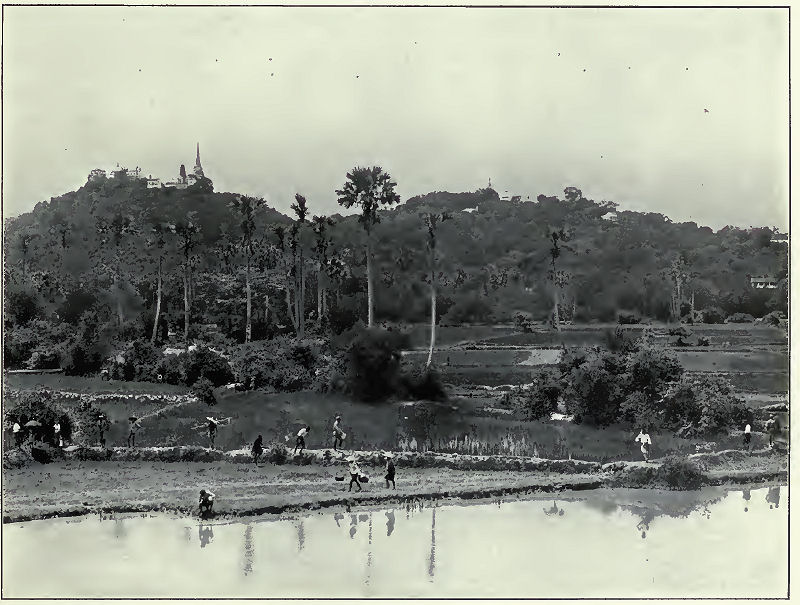
Abb.: Bei Phetchaburi - เพชรบุรี
[Quelle:
Twentieth century impressions of Siam : its history, people, commerce,
industries, and resources / ed. in chief: Arnold Wright. -- London [etc.] :
Lloyds, 1908. -- S. 31]
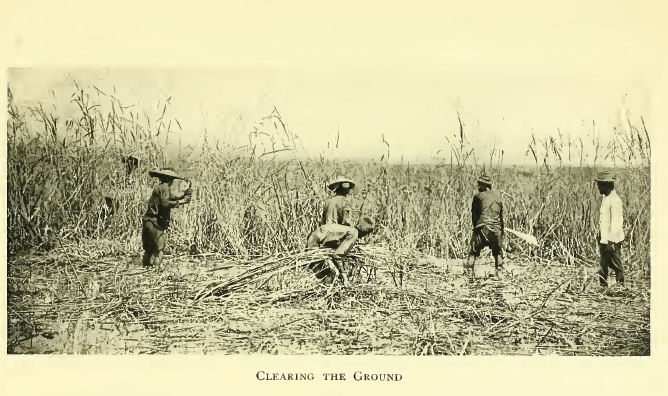
Abb.: Rodung
[Bildquelle:
The kingdom of Siam : Ministry of
Agriculture, Louisiana Purchase Exposition, St. Louis, U.S.A., 1904 ; Siamese
section / ed. by A. Cecil Carter. -- New York: Putnam’s Sons, 1904. -- Nach S.
154]
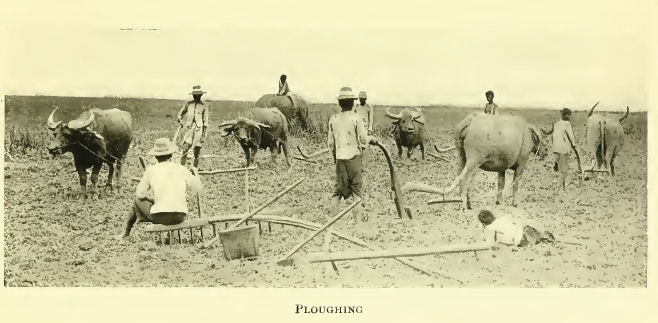
Abb.: Pflügen der Reisfelder
[Bildquelle:
The kingdom of Siam : Ministry of
Agriculture, Louisiana Purchase Exposition, St. Louis, U.S.A., 1904 ; Siamese
section / ed. by A. Cecil Carter. -- New York: Putnam’s Sons, 1904. -- Nach S.
50]
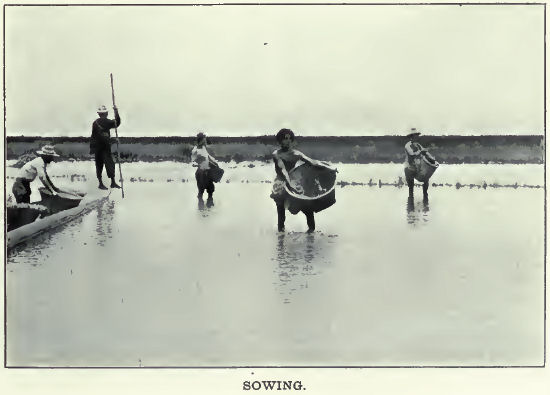
Abb.: Aussaat der Reis-Saat
[Bildquelle: Twentieth century impressions of Siam : its history, people,
commerce, industries, and resources / ed. in chief: Arnold Wright. -- London
[etc.] : Lloyds, 1908. -- S. 145]
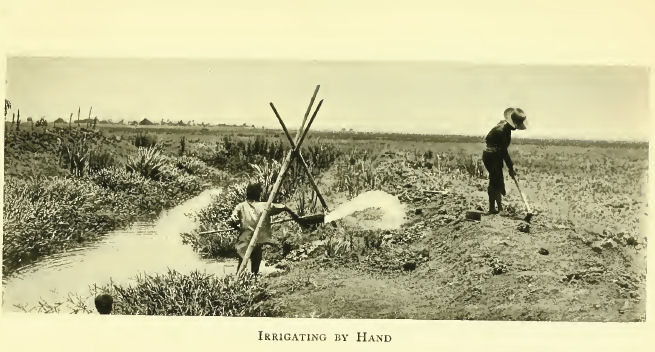
Abb.: Bewässerung von Hand
[Bildquelle:
The kingdom of Siam : Ministry of
Agriculture, Louisiana Purchase Exposition, St. Louis, U.S.A., 1904 ; Siamese
section / ed. by A. Cecil Carter. -- New York: Putnam’s Sons, 1904. -- Nach S.
162]
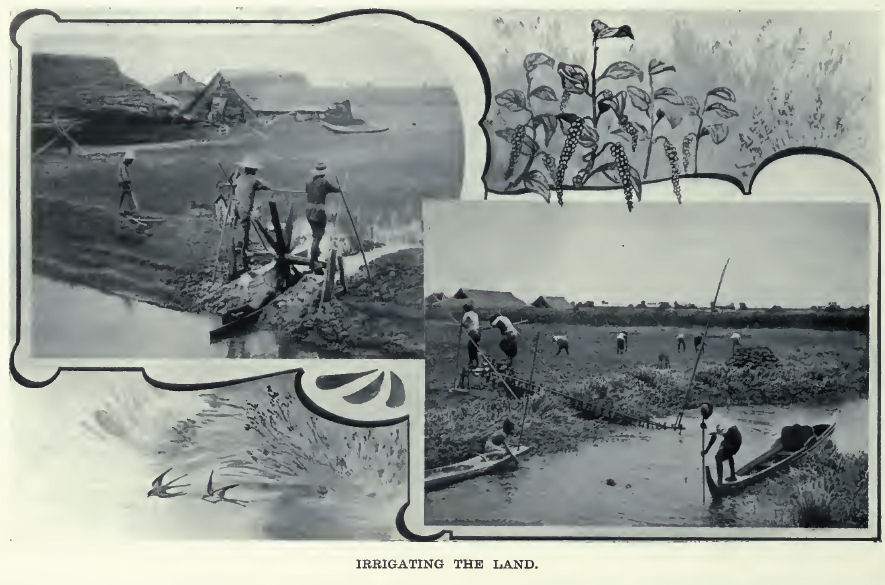
Abb.: Bewässern der Reisfelder
[Bildquelle: Twentieth century impressions of Siam : its history, people,
commerce, industries, and resources / ed. in chief: Arnold Wright. -- London
[etc.] : Lloyds, 1908. -- S. 146]
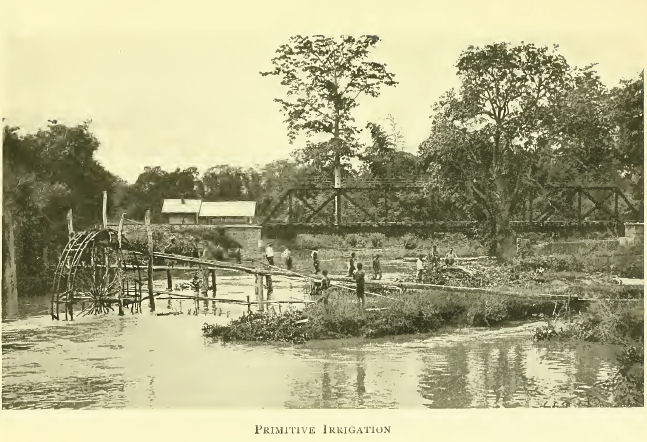
Abb.: Bewässerungsanlage
[Bildquelle:
The kingdom of Siam : Ministry of
Agriculture, Louisiana Purchase Exposition, St. Louis, U.S.A., 1904 ; Siamese
section / ed. by A. Cecil Carter. -- New York: Putnam’s Sons, 1904. -- Nach S.
54]
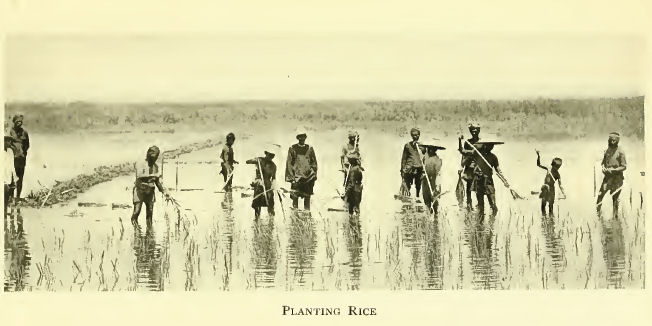
Abb.: Umpflanzen der Reis-Setzlinge
[Bildquelle:
The kingdom of Siam : Ministry of
Agriculture, Louisiana Purchase Exposition, St. Louis, U.S.A., 1904 ; Siamese
section / ed. by A. Cecil Carter. -- New York: Putnam’s Sons, 1904. -- Nach S.
158]
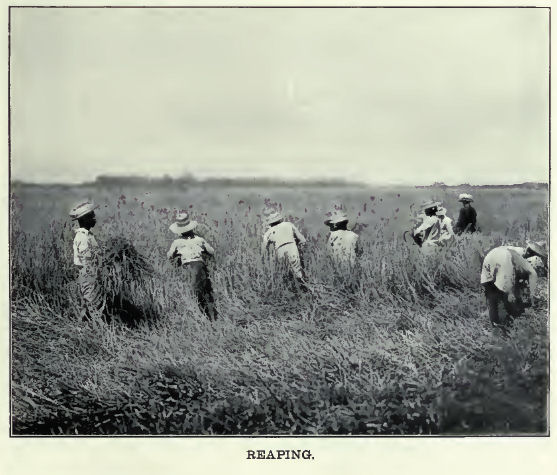
Abb.: Reis-Ernte
[Bildquelle: Twentieth century impressions of Siam : its history, people,
commerce, industries, and resources / ed. in chief: Arnold Wright. -- London
[etc.] : Lloyds, 1908. -- S. 147]
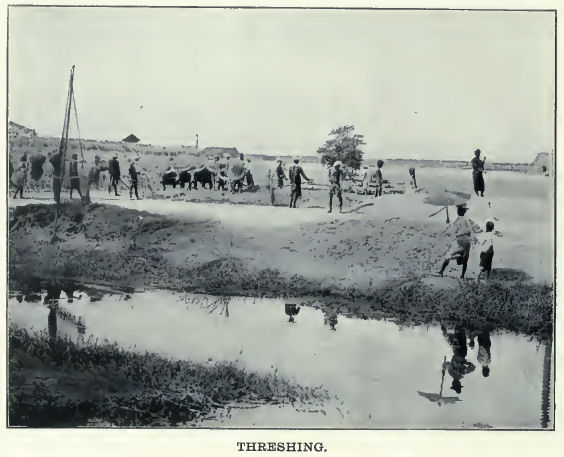
Abb.: Dreschen des Reis
[Bildquelle: Twentieth century impressions of Siam : its history, people,
commerce, industries, and resources / ed. in chief: Arnold Wright. -- London
[etc.] : Lloyds, 1908. -- S. 148]
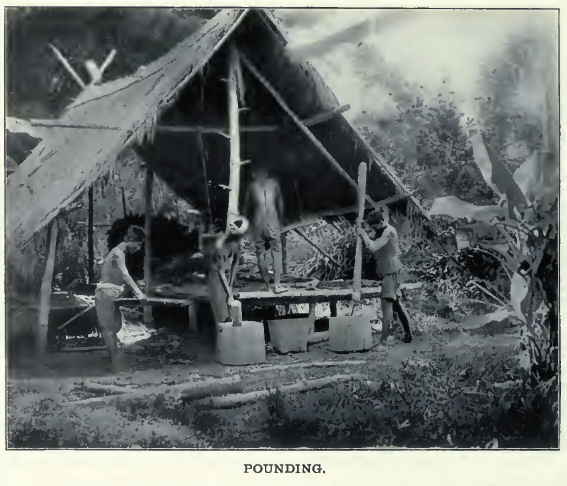
Abb.: Stampfen des Reis'
[Bildquelle: Twentieth century impressions of Siam : its history, people,
commerce, industries, and resources / ed. in chief: Arnold Wright. -- London
[etc.] : Lloyds, 1908. -- S. 148]
"Considering the conditions under which the crops have been worked, it says a good deal for the industry of the native farmers that the yield of grain in Siam has increased as it has done during the past fifteen or twenty years. Twenty years ago Siam rice was little known to the outside world, and the rice crop was insignificantly small; but now, the export in one year is nearly one million tons of milled grain. When it is remembered that the staple trade of the country has increased as it has done with very little help from the Government, one is struck with the great possibilities of the future.
What has contributed very greatly to the increased cultivation is the extensive irrigation work that has been going on for many years between Bangkok and the north and the Patriew river, the outcome of an edict of his Majesty King Chulalongkorn, dated about 1891, whereby concessions were granted to those opening up the land by cutting and dredging. This particular cutting, which is worked by a private concern, affects a large area of good paddy-growing land. There is considerable scope for similar works all through the country, and the subject has been under the consideration of the Siamese Government for some lime. In all other parts of the country the cultivators have to depend on the usual primitive methods of regulating the water on the fields, and, naturally, they are to a large extent at the mercy of the rains and floods. Excessive rain, however, does not cause so much anxiety to the farmer as excessive drought.
The rainfall of Siam is not heavy compared to that experienced in the chief rice-growing districts of India and Burma. In the districts immediately around Bangkok the average annual rainfall is only about fifty inches, but it is somewhat heavier in other parts. The rains break usually during the month of May, and ploughing operations are begun as soon afterwards as opportunity offers. The ploughing process is very rough and old-fashioned, and the furrow is neither deep nor wide. Buffaloes and oxen are employed to draw the plough, which is usually lightly made out of part of a tree, a metal ploughshare being fixed at the junction between the branch and the trunk; the harrow used is composed of wood and bamboo, and is also a light implement compared to those used in Europe. It must, of course, be remembered that the ground is always under water when ploughing and harrowing are being done.
Planting is generally in full swing during the month of July, although, under more favourable conditions, some fields are in an advanced state by this time. There are two distinct kinds of paddy cultivated in Siam—one the "Namuang" or field rice, and the other the "Nasuan" or garden rice.
The Namuang is a small roundish grain, peculiarly red. It is grown on the lower levels, and the plants reach a great height, growing up strongly through the water as high as eight or nine feet, according to the rise of the level of floods on the fields. Nowadays the crop of Namuang paddy is small compared to Nasuan, as there is no inducement to increase the output of the inferior grain. There are certain places, however, where no other kind of rice can be reared, so that Namuang paddy will always form a portion of the crop. At present probably about fifteen or twenty per cent, of the export from Siam is Namuang.
The Nasuan grain is of a very varied description, depending on the district or districts from which it comes. Real Nasuan, however, is a beautiful long grain from which excellent results are obtained in milling. The best quality of Nasuan comes from the Naconchaisee district. Unlike Namuang, Nasuan does not grow up with the water, but, being weaker, is liable to fall and "drown" when floods come too quickly or last too long. The ordinary height of the Nasuan plant is five to six feet. Namuang is sown broadcast and grows up from the seed, but the bulk of the Nasuan grain is started in nurseries and is transplanted out into the field by hand after it reaches a growth of about a foot or a little more. This transplanting is done very adroitly by all the natives—men, women, and children alike engaging together in the work—and is an interesting feature of cultivation. The ground into which the plants are being put is, of course, covered with water to a considerable depth, and working under such conditions as these the villagers appear to be in their element. The percentage of Nasuan paddy grown from the seed which is called Na-warn is, it is to be feared, on the increase. It is hoped that the farmers will in the future try to alter this. The net result of the system of growing the two kinds would appear to be the gradual deterioration of a first-class grain. It is found that with good seed, similar to what is sown in the Naconchaisee locality, the farmers on the fine nurseries along Klong Rangsit—the area covered by the irrigation works of which mention has been made—can rear as good grain as has ever been produced in the country, but irrigation and attention to transplanting are required.
Planting and transplanting are continued up to the month of October, and the early grain is being cut in November, but the reaping does not become general until late in December. Quite a large portion of the Nasuan crop is cut while there is still water on the fields, and at such times a boat is requisitioned for the purpose of conveying the paddy to the barns. All the paddy crop is cut down by hand, such a thing as a reaping machine being unknown. It is when the harvesting is in full swing that the shortness of labour is felt most by the farmers. To gather in crops expeditiously enough is impossible, and thus it happens that large quantities of grain remain too long on the fields, pass through several heavy showers, and then get sun-dried, and made so brittle as to break in the husk before reaching the mills.
The Namuang crop, which is high in the water, does not ripen so quickly, and there is very little of this grain ready for cutting before February or March. It is generally reckoned to be three months later than the Nasuan crop.
Threshing is done on a comparatively small circular piece of ground, which is levelled off and covered with a mixture of mud and manure. When it becomes dry this preparation leaves a fine, even surface which is not liable to crack or break up. The usual procedure then is to erect a pole on the centre and attach a pair of bullocks to this pole by a piece of rope and a band made of rattans or metal and drive the bullocks around in the circle, which is kept filled with the cut paddy. Threshing in the villages furnishes an opportunity for considerable frolic, as the young people are romping about amongst the straw most of the time, while in the evening the place is probably aglow with the light of a huge stubble and straw fire.
The method employed of winnowing the grain is very simple and it is not by any means thorough. The system is merely to switch the paddy upward with a stick and to allow the wind to blow away the chaff. In some districts winnowing would appear to be honoured more in the breach than in the observance !
After winnowing, the grain is stored away in bins, which are sufficiently high from the ground to keep their contents dry. The bins are protected from the rain by a roof of "attap" or other leaves and bamboo and mud walls. Here the paddy will sometimes remain for weeks or months or maybe years, and the farmer's wealth is often computed by the fullness of his rice-bins.
In many cases, however, the farmer will sell, almost at once, the whole or part of his grain to a person who is usually known as the "middleman." The object of this early sale is to enable the farmer to pay Government taxes then falling due. The middleman, who is probably a Chinaman, owning a fleet of four or more paddy boats, is sure to have made a safe bargain, and this, to the ordinary onlooker, is one of the most unfortunate features of the trade, namely, that the farmer who works so hard scarcely ever enjoys the benefit of the good prices when they are in vogue. Doubtless, in time to come, this will change to a great extent, as with the opening up of the country by railways the farmers will get into closer touch with the markets.
During the past few years the railway has been used to bring in 40,000 tons to 70,000 tons of paddy to Bangkok, but the remainder has come by boat through rivers and canals (Klongs as they are called). Every description of boat may be seen on the Menam, and there is quite 'a variety used for carrying paddy. For transport from the places around Bangkok only small boats, carrying 5 to 15 tons, are employed, but for more distant places larger craft are engaged, some of which will carry from 30 to 35 tons. The small boats are for the most part open, but they carry bamboo frames and mat covers for use in case of rain. The big boats are all covered with a framework of wood and bamboo, and accommodation is provided at the after end for the family who make their home on the boat, while sufficient space is also allowed in the body of the boat above the paddy for the three or four men who form the crew. These boats will sometimes spend three or four weeks on one trip, covering a distance of a hundred and fifty to two hundred miles. Loaded, these large boats draw 6 to 8 feet of water, but when empty only about 2 feet.
On arrival at the reaches of the river above Bangkok the boats are met by "runners" from all the different mills—and nowadays sometimes even by launches—offering to tow the boats down gratis to that particular mill to which the runner or the launch belongs. The runners inform the boatmen what is the nature of the demand for paddy and what particular mill is the strongest buyer, and also, it is quite probable, in their anxiety to bring about a "deal," give a good deal of information which is quite untrue.
So the wily boat-owner when he arrives in the market at Bangkok is fully posted as to the conditions of trade prevailing and waits or sells his cargo at once to the highest bidder, according as he judges the situation. There are some boats that will go to the same mill trip after trip as a matter of course, the owner accepting the price ruling at that particular mill, which is always understood to be a fair market price. In some instances even the boats are bound to a certain mill because they have received an advance on account of the paddy. Fortunately, however, the advance system is not at all common in Siam, at least as far as the paddy crop is concerned.
As an instance of the growth of the rice trade at Bangkok one has only to look at the enormous increase in the number of mills during the past ten or fifteen years. In 1893 the total number of mills at work was 23, while at the present moment there are 49, of which all but two have been working this year. Without a doubt the mills are far in excess of requirements, and thus it is that the paddy market fluctuates so considerably. Out of the above total of mills only three are in the hands of Europeans (two British firms and one German) ; the remainder all belong to Chinese or Siamese, but chiefly to the former.
The Chinese have always predominated in the rice trade, and quite naturally so too, seeing that the bulk of the crop has formerly gone to Hongkong and China ports. Even before the days of regular steamer communication between Siam and the port of Hongkong the Chinese used to run their fleets of sailing ships and junks to Bangkok, exchanging general merchandise for rice.
In recent years there has been more business done by the mills for Europe, and the European element seems likely to become stronger as the trade expands. The three European firms represented in the trade are all firms of good standing, and most of the Chinese engaged in milling are also either of considerable wealth in themselves or else they are well backed up by their connection in Hongkong and Singapore. In some years good profits are made by millers and the partners in some of the Chinese firms have acquired large fortunes in times past. More recently, however, the trade has been anything but flourishing, and this notwithstanding the larger export.
Some people attribute the cause of the recent unsatisfactory state of affairs to the way exchange has been moving up against the exporter. Probably the exchange question has had an important influence in the matter, but keen competition between the mills has also contributed towards the diminution of the profits.
In the early nineties only a small proportion of the Bangkok mills were able to make white rice, for the reason that the chief market—China—wanted rough or cargo rice, which the people of China treated themselves in their pounding mills. There has, however, been a gradual change, and practically all the mills are now able to turn out well-finished white rice.
The comparative figures of exports for the past seven years given below will help to illustrate how cargo rice is falling off as an export in favour of white rice."
[Quelle: A. E. Stiven in: Twentieth century impressions of Siam : its history, people, commerce, industries, and resources / ed. in chief: Arnold Wright. -- London [etc.] : Lloyds, 1908. -- S. 144ff.]
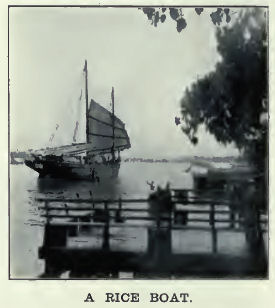
Abb.: Reis-Transport
[Bildquelle: Twentieth century impressions of Siam : its history, people,
commerce, industries, and resources / ed. in chief: Arnold Wright. -- London
[etc.] : Lloyds, 1908. -- S. 148]
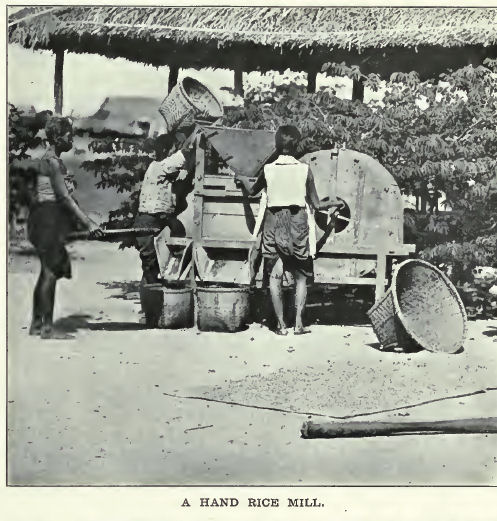
Abb.: Handbetriebene Reismühle
[Bildquelle: Twentieth century impressions of Siam : its history, people,
commerce, industries, and resources / ed. in chief: Arnold Wright. -- London
[etc.] : Lloyds, 1908. -- S. 187]
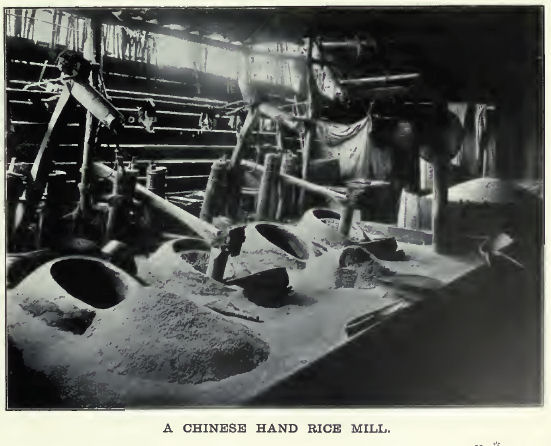
Abb.: Handmühle für Reis, in chinesischem Besitz
[Bildquelle: Twentieth century impressions of Siam : its history, people,
commerce, industries, and resources / ed. in chief: Arnold Wright. -- London
[etc.] : Lloyds, 1908. -- S. 149]
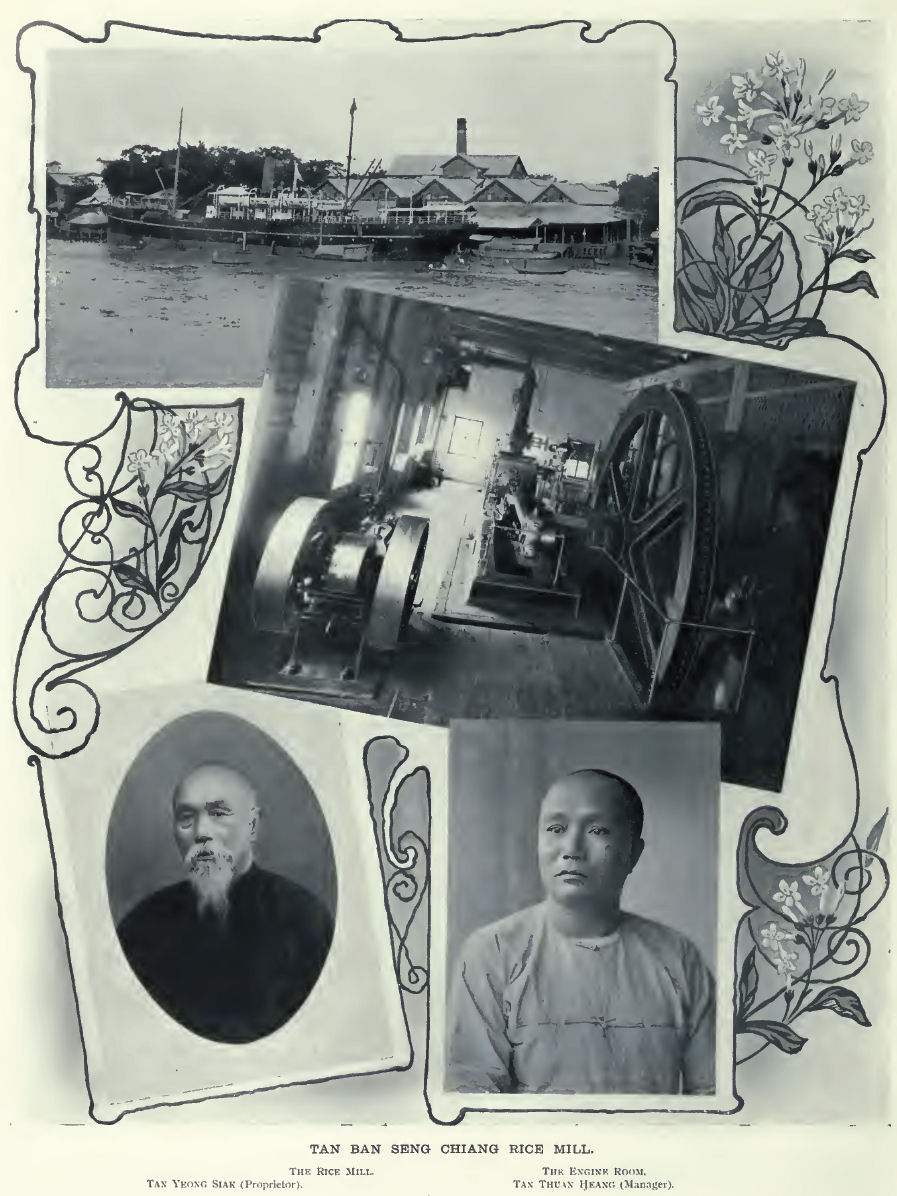
Abb.: Tan Ban Seng Chiang Reis-Mühle
[Bildquelle: Twentieth century impressions of Siam : its history, people,
commerce, industries, and resources / ed. in chief: Arnold Wright. -- London
[etc.] : Lloyds, 1908. -- S. 1158]
"TAN BAN SENG CHIANG RICE MILL.
The Tan Ban Seng Chiang mill, which is situated on the east bank of the Menam river, was established some twelve years ago by a well-known Chinese named Mr. Tan Yeong Siak. This mill and one adjoining it were, for some time, operated conjointly by Mr. Tan Yeong Siak, and the Singapore firm of Messrs. Ban Seng. In 1907, however, this partnership was dissolved and the Tan Ban Seng Chiang Mill was taken over entirely by Mr. Tan Yeong Siak, and is now managed by his son, Mr. Tan Thuan Heang. The mill is well equipped with modern machinery, which is under the charge of a European engineer, and can turn out 2,000 piculs (擔) of the first quality white rice or 2,800 piculs of cargo rice during the twenty-four hours. But beside the mill Mr. Tan Yeong Siak has many other interests. He has an office at Singapore under the name of Ban Seng Soon, a branch at Kebli, where a considerable import and export trade is carried on, five or six years ago by Towkay Bang Yui Yuen, a native of the Kiang Chew province of China, who has been a resident in Siam for the last sixteen years. The mills are conveniently situated on the banks of klongs (canals) running into the Menam river, and have a combined output of 2,600 piculs of the best rice a day. Every grade of rice is produced and exported to Hongkong, Singapore, and Europe, the work of loading being greatly facilitated by the excellent wharves which each mill possesses. The firm's agent in Singapore is Tong Keng of Market Street, while We Seng and Guan Teck have charge of the firm's interests in Hongkong. In addition to his rice milling operations Towkay Bang Yui Yuen, having purchased a forest concession in the North of Siam and founded two hand sawmills, is now carrying on a large trade in timber. He is also the Managing Director of the Guan What Lee Chinese Bank, which he and a few friends established some three years ago."
[Quelle: Twentieth century impressions of Siam : its history, people, commerce, industries, and resources / ed. in chief: Arnold Wright. -- London [etc.] : Lloyds, 1908. -- S. 157]
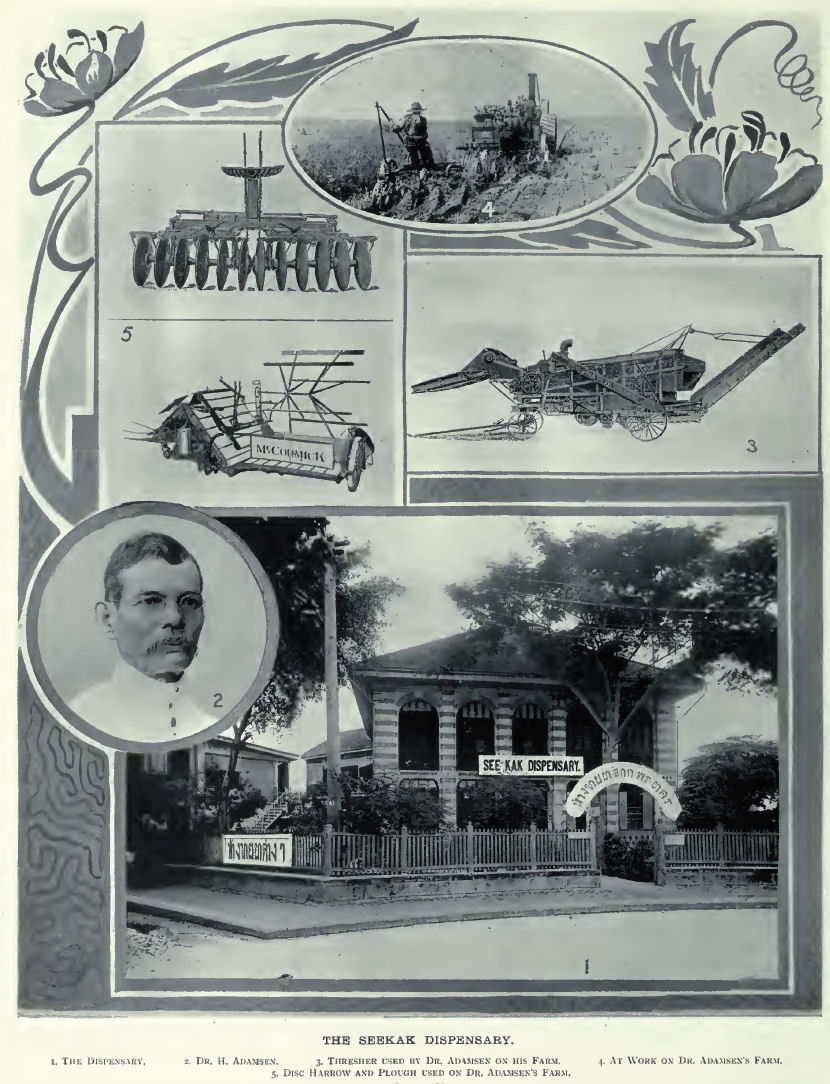
Abb.: Der Apotheker Dr. H. Adamsen verwendete auf seinen Feldern ab 1904
modernste amerikanische und britische Landmaschinen
[Bildquelle: Twentieth century impressions of Siam : its history, people,
commerce, industries, and resources / ed. in chief: Arnold Wright. -- London
[etc.] : Lloyds, 1908. -- S. 276]
"SEEKAK DISPENSARY.
Dr. H. Adamsen, the proprietor of the Seekak Dispensary, can look back with pride upon his record in the medical world of Siam, the land of his birth. He left home at the age of twelve and joined the Marine Service, returning to Siam at the age of eighteen, in time to leave for America with Mr. J. H. Chandler, a missionary from Bangkok, to whom Dr. Adamsen is indebted for much help in the early stages of his medical career. He received a preparatory education at the Suffield Institution, Conn., U.S.A. ; his collegiate course was passed at Bucknell University, Louisburg, Penn., and his medical course at Jefferson Medical College, Philadelphia, where he graduated in 1888, returning again three years later, married, to Siam. On his arrival in Bangkok he started a private practice, and at the same time opened the Seekak Dispensary.
[...]
While in America Dr. Adamsen was in the habit of spending his vacations in the country, and became familiar with farming in all its branches. Always retaining in mind the possibility of introducing farming machinery into Siam, he purchased, in 1904, a farm of 450 acres in the Klong Rangsit district, and with imported American and British machinery—comprising threshing and reaping machines, disc ploughs and harrows—he succeeded, in the end, in proving to the natives that machinery can be used as successfully in Siam as in North and South Carolina. Dr. Adamsen's grain was the first reaped by machinery in Siam. Since, however, he has achieved success, companies and syndicates have been formed to cultivate large areas of land in similar manner."
[Quelle: Twentieth century impressions of Siam : its history, people, commerce, industries, and resources / ed. in chief: Arnold Wright. -- London [etc.] : Lloyds, 1908. -- S. 278]
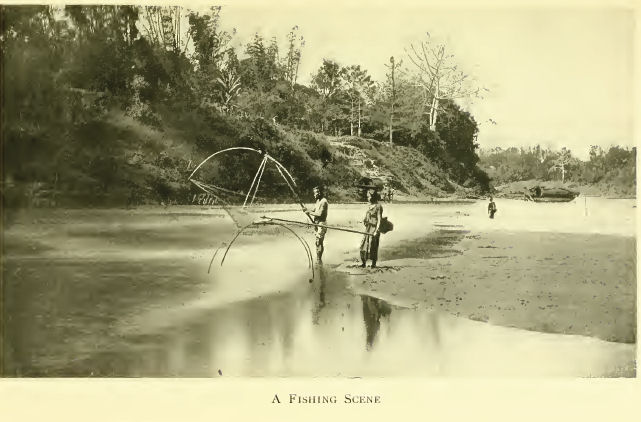
Abb.: Fischer
[Bildquelle:
The kingdom of Siam : Ministry of
Agriculture, Louisiana Purchase Exposition, St. Louis, U.S.A., 1904 ; Siamese
section / ed. by A. Cecil Carter. -- New York: Putnam’s Sons, 1904. -- Nach S.
268]
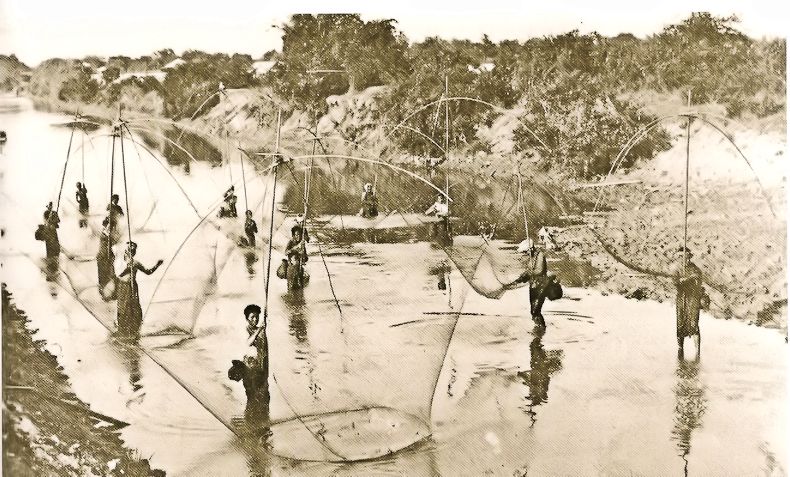
Abb.: Fischer
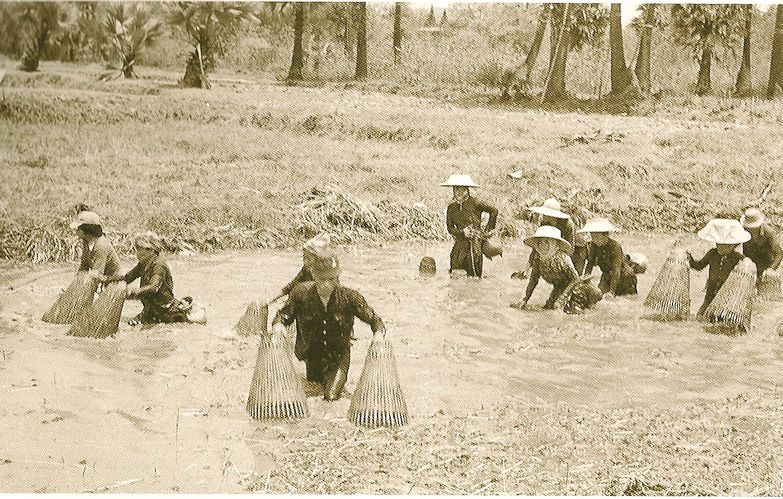
Abb.: Fischerinnen und Fischer, Petchaburi (เพชรบุรี)
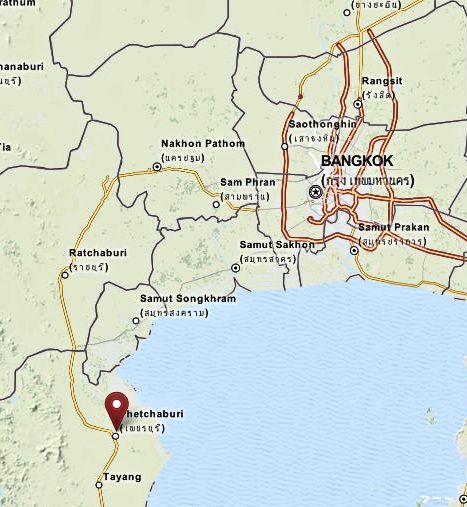
Abb.: Lage von Petchaburi (เพชรบุรี)
[Bildquelle: OpenStreetMap. --
Creative
Commons Lizenz (Namensnennung, share alike)]
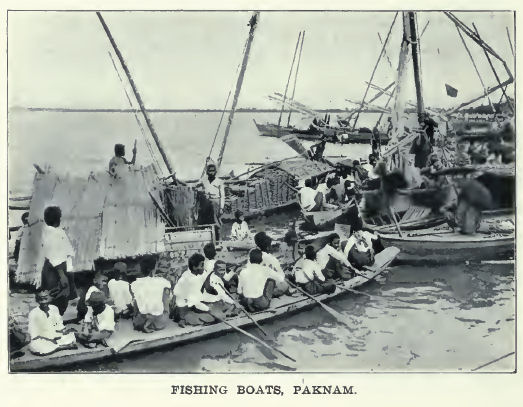
Abb.: Fischerboote, Paknam - ปากน้ำ
[Bildquelle: Twentieth century impressions of Siam : its history, people,
commerce, industries, and resources / ed. in chief: Arnold Wright. -- London
[etc.] : Lloyds, 1908. -- S. 248]
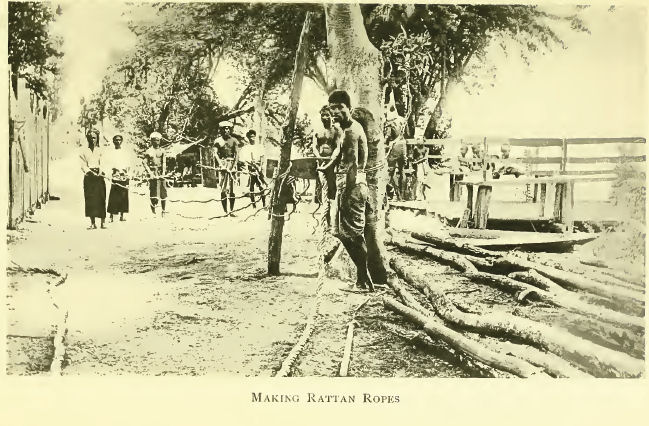
Abb.: Herstellung von Rattan-Seilen
[Bildquelle:
The kingdom of Siam : Ministry of
Agriculture, Louisiana Purchase Exposition, St. Louis, U.S.A., 1904 ; Siamese
section / ed. by A. Cecil Carter. -- New York: Putnam’s Sons, 1904. -- Nach S.
256]
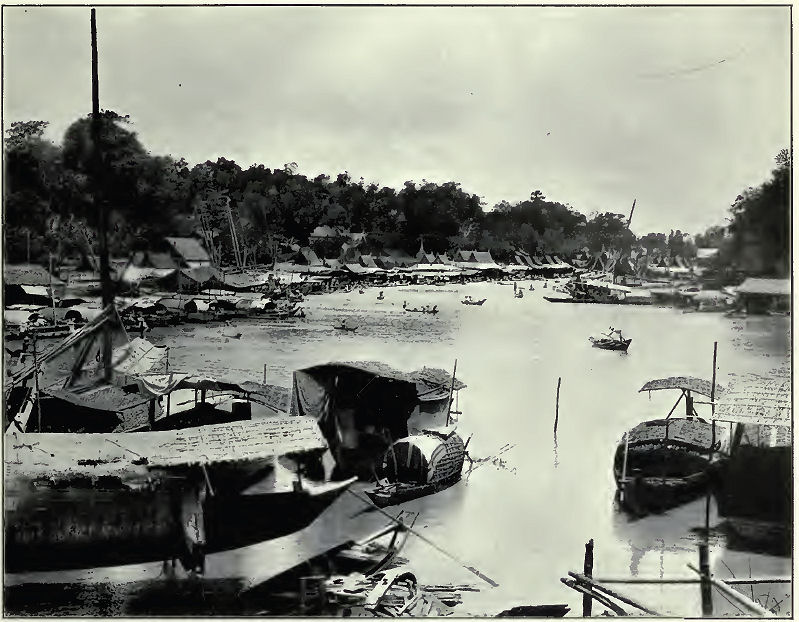
Abb.: Schwimmender Markt in Ayutthaya - อยุธยา
[Bildquelle:
Twentieth century impressions of Siam : its history, people, commerce,
industries, and resources / ed. in chief: Arnold Wright. -- London [etc.] :
Lloyds, 1908. -- S. 21]
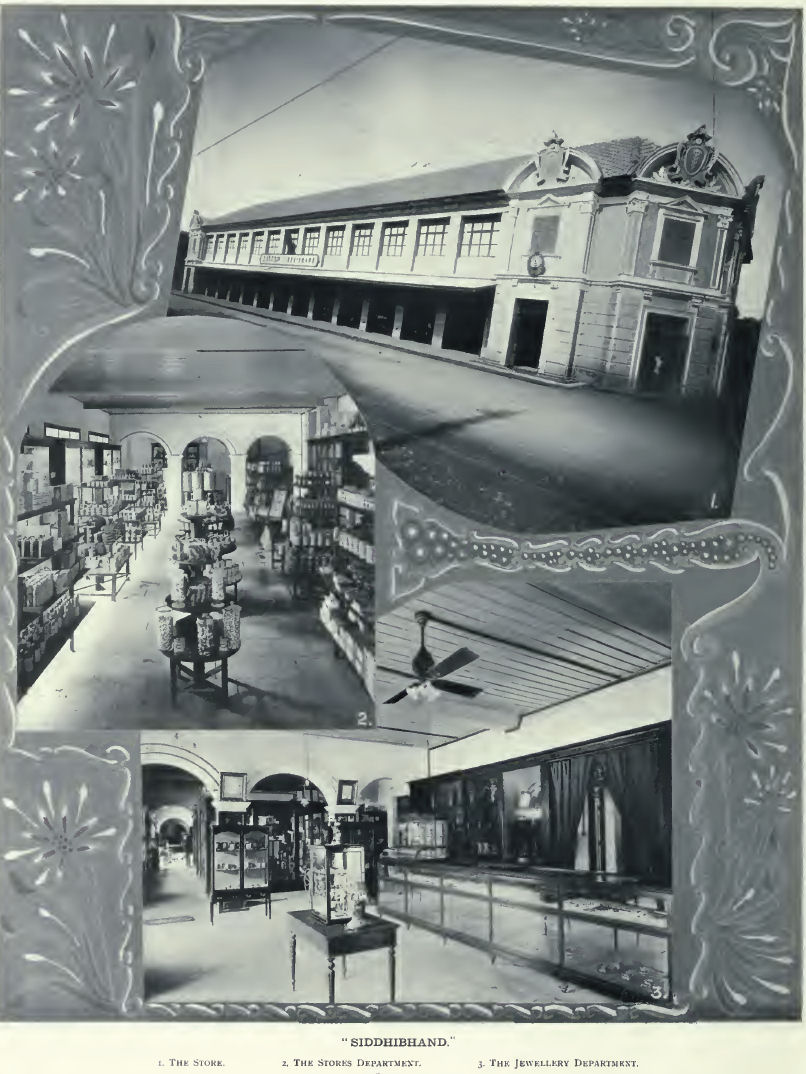
Abb.: Siddhibhand
[Bildquelle: Twentieth century impressions of Siam : its history, people,
commerce, industries, and resources / ed. in chief: Arnold Wright. -- London
[etc.] : Lloyds, 1908. -- S. 257]
"SIDDHIBHAND.
The premier Siamese store in Bangkok is the " Siddhibhand," which is situated within easy reach of the palace and Government offices at Feung Nakara Road, Charoen Krung Square. The company hold an appointment from H.R.H. the Crown Prince, and enjoy the patronage and support of many of the princes and nobles of Siam. Their chief business, perhaps, is that of house-furnishing, in which department of activity they are recognised specialists, some of the work which they have carried through rivalling, both in regard to style and tasteful arrangement, anything that might have been done by the large European houses. In addition to the furnishing department there is a general department, where the stock includes such diverse articles as saddlery, statuary, jewellery, and soft goods. The Rathakitch carriage works are carried on in conjunction with the " Siddhibhand." Here also a very high class trade is done; for the works receive the support and secure orders from all the leading members of the Siamese community."
[Quelle: Twentieth century impressions of Siam : its history, people, commerce, industries, and resources / ed. in chief: Arnold Wright. -- London [etc.] : Lloyds, 1908. -- S. 257]
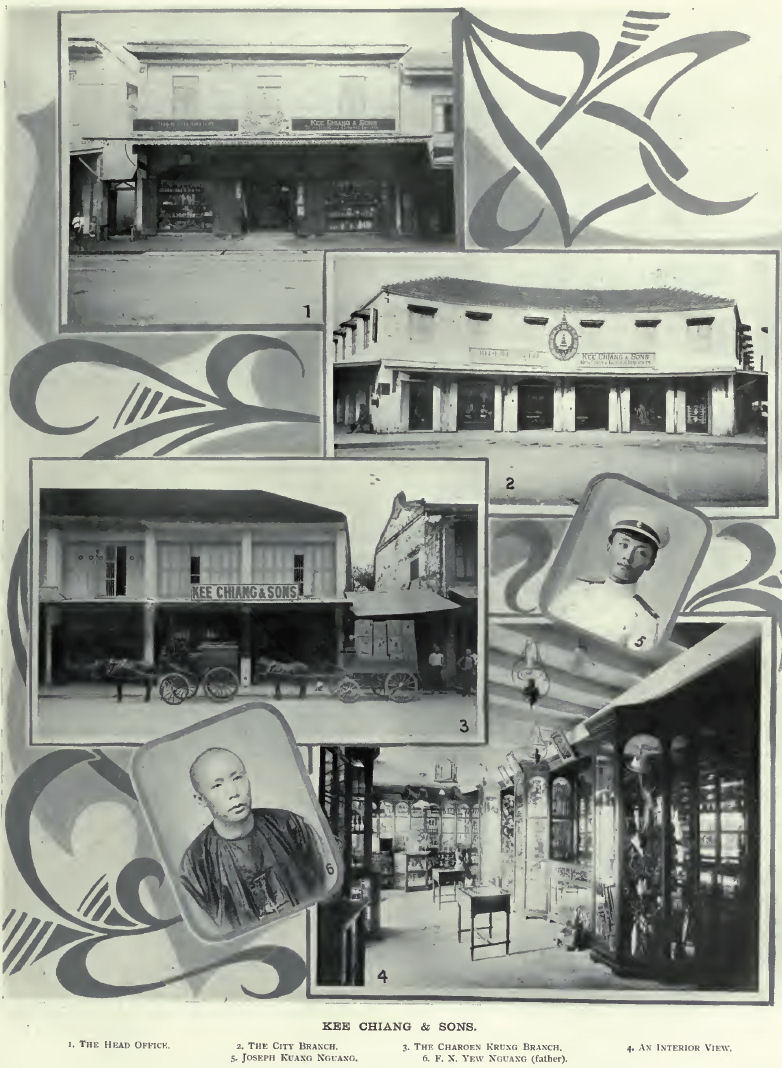
Abb.: Kee Chiang & Sons
[Bildquelle: Twentieth century impressions of Siam : its history, people,
commerce, industries, and resources / ed. in chief: Arnold Wright. -- London
[etc.] : Lloyds, 1908. -- S. 258]
"KEE CHIANG & SONS.
The business of Kee Chiang & Sons, which was established in quite a small way some sixteen years ago, has now grown into one of the largest enterprises of its kind in Bangkok. This success has been due to good organisation and largely to the good management of the business on the part of its founder, Mr. F. X. Yew Nguang and his son, Mr. Joseph Kuang Nguang. As the trade grew branches were opened first in the Talatnoi quarter, and afterwards in the city proper ; for as the firm hold an appointment from H.R.H. the Crown Prince, and are continually receiving royal support and patronage, it was considered essential that, for the convenience of their royal customers, they should have premises as near as possible to the King's palace and the Government offices.
Mr. Joseph Kuang Nguang was born and educated in Bangkok. He showed a special aptitude for languages, and was soon able to speak English, French, and Chinese quite fluently. After leaving school in order to complete his education and for the purpose of studying business methods in different countries, he paid visits to all the chief commercial towns of Europe and the East. Mr. Kuang Nguang is a believer in the Christian religion, and during his tour was received in audience by Pope Pius X., the Archbishop of Westminster, and the Archbishop of Paris. In addition to his business responsibilities he now carries out the honourable duties attaching to the office of page to H.R.H. the Crown Prince of Siam. Mr. Kuang Nguang is married to Lim Sew Hong, the daughter of a prominent Bangkok merchant."
[Quelle: Twentieth century impressions of Siam : its history, people, commerce, industries, and resources / ed. in chief: Arnold Wright. -- London [etc.] : Lloyds, 1908. -- S. 257f.]
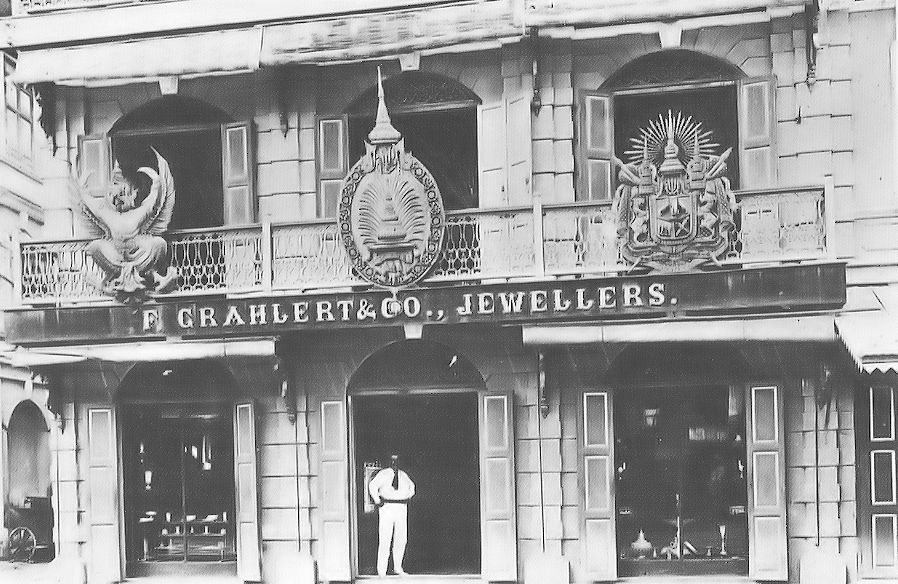
Abb.: Juwelier F. Grahlert & Co., Tanao Road (ถนนตะนาว)
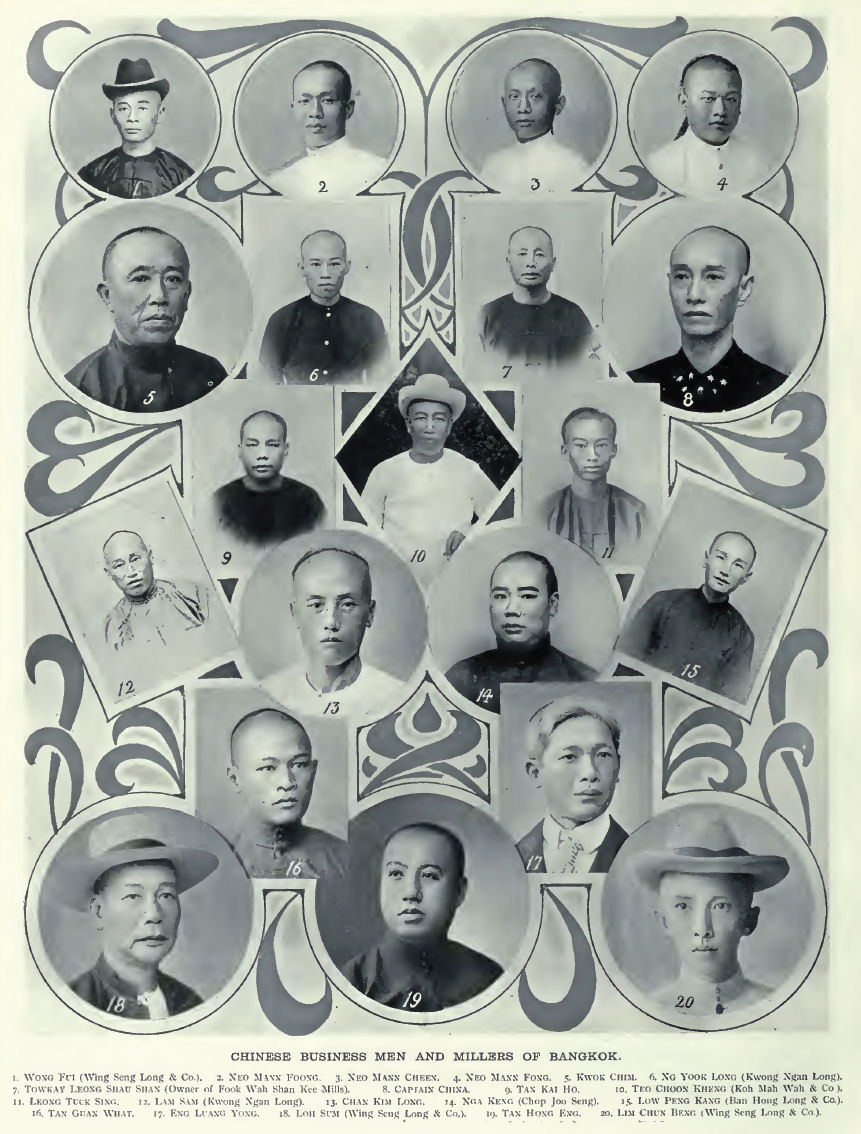
Abb.: Chinesische Geschäftsleute und
Reis-Müller in Bangkok
[Bildquelle: Twentieth century impressions of Siam : its history, people,
commerce, industries, and resources / ed. in chief: Arnold Wright. -- London
[etc.] : Lloyds, 1908. -- S. 284]
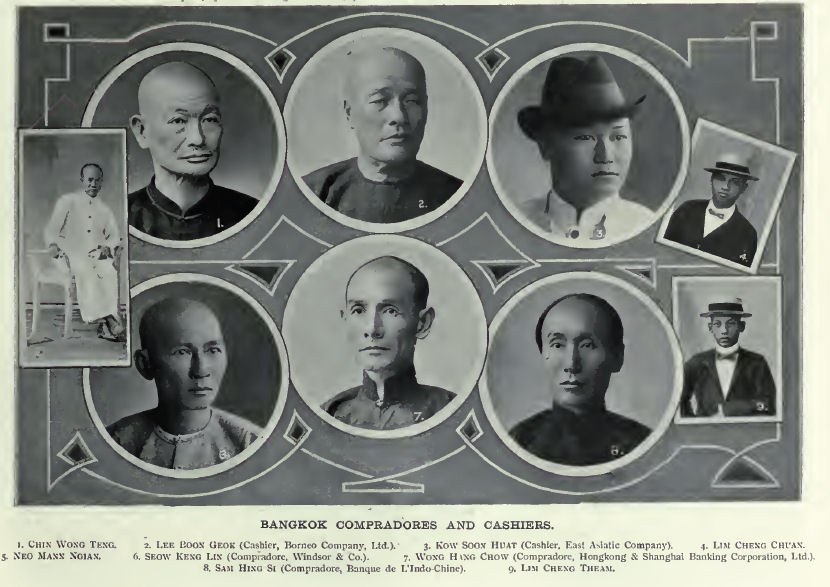
Abb.: Chinesische Kompradore in Bangkok
[Bildquelle: Twentieth century impressions of Siam : its history, people,
commerce, industries, and resources / ed. in chief: Arnold Wright. -- London
[etc.] : Lloyds, 1908. -- S. 287]
"Die Institution des Komprador (chinesisch maiban - 買辦) spielte im 19. Jahrhundert eine wichtige Rolle im Handel Chinas mit dem Westen. Seit dem Opiumkrieg waren zwar einige Vertragshäfen für westliche Händler geöffnet, sie konnten aber lange weder in das Landesinnere noch in die komplexen chinesischen Handelsstrukturen eindringen. Hier fungierte der Komprador als Vermittler. Er war das Oberhaupt des chinesischen Personals eines ausländischen Unternehmens (chinesisch yang-hang) und rekrutierte, beaufsichtigte und bezahlte die chinesischen Arbeitskräfte. Er gewann für seine Firma chinesische Kunden, führte die Geschäftsverhandlungen mit ihnen und beurteilte ihre Kreditwürdigkeit. Der Komprador war somit die chinaspezifische Antwort auf das Grundproblem interkulturellen Handels, die Überbrückung von Barrieren wie unterschiedliche Sprache und Schrift sowie unterschiedliche Geschäftspraktiken.
Im 20. Jahrhundert wurde der Komprador zunehmend durch technisch oder kaufmännisch gebildete, chinesische Angestellte ersetzt. Viele Kompradoren konnten ihre Tätigkeit jedoch nutzen, um selbst zu erfolgreichen Geschäftsleuten zu werden.
Literatur
- Osterhammel, Jürgen: China und die Weltgesellschaft. Vom 18. Jahrhundert bis in unsere Zeit, München 1989, ISBN 3-406-34099-7
- Benecke, Günther: Der Komprador. Ein Beitrag zur Entwicklungsgeschichte der einheimischen Handelsvermittlung in China, in: Weltwirtschaftliches Archiv 18, 1922, S. 377-413, 525-556."
[Quelle: http://de.wikipedia.org/wiki/Komprador. -- Zugriff am 2011-10-18]
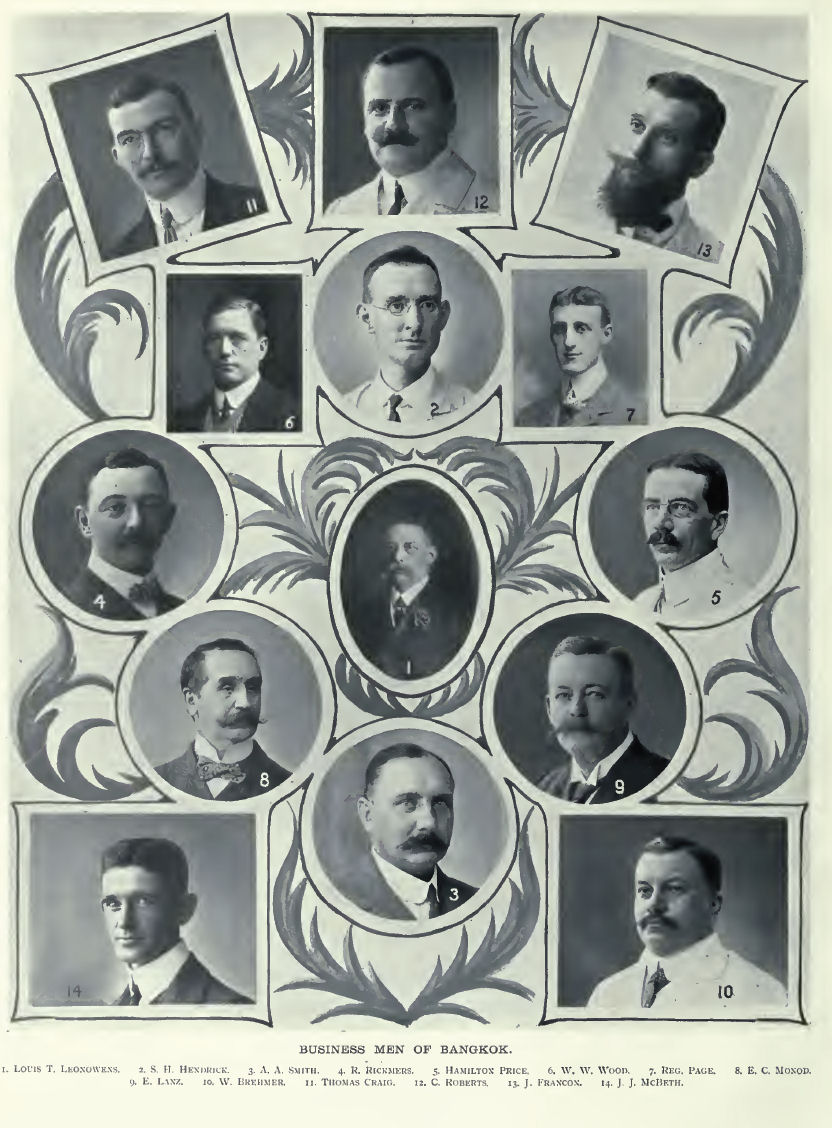
Abb.: Westliche Geschäftsleute in Bangkok
[Bildquelle: Twentieth century impressions of Siam : its history, people,
commerce, industries, and resources / ed. in chief: Arnold Wright. -- London
[etc.] : Lloyds, 1908. -- S. 264]
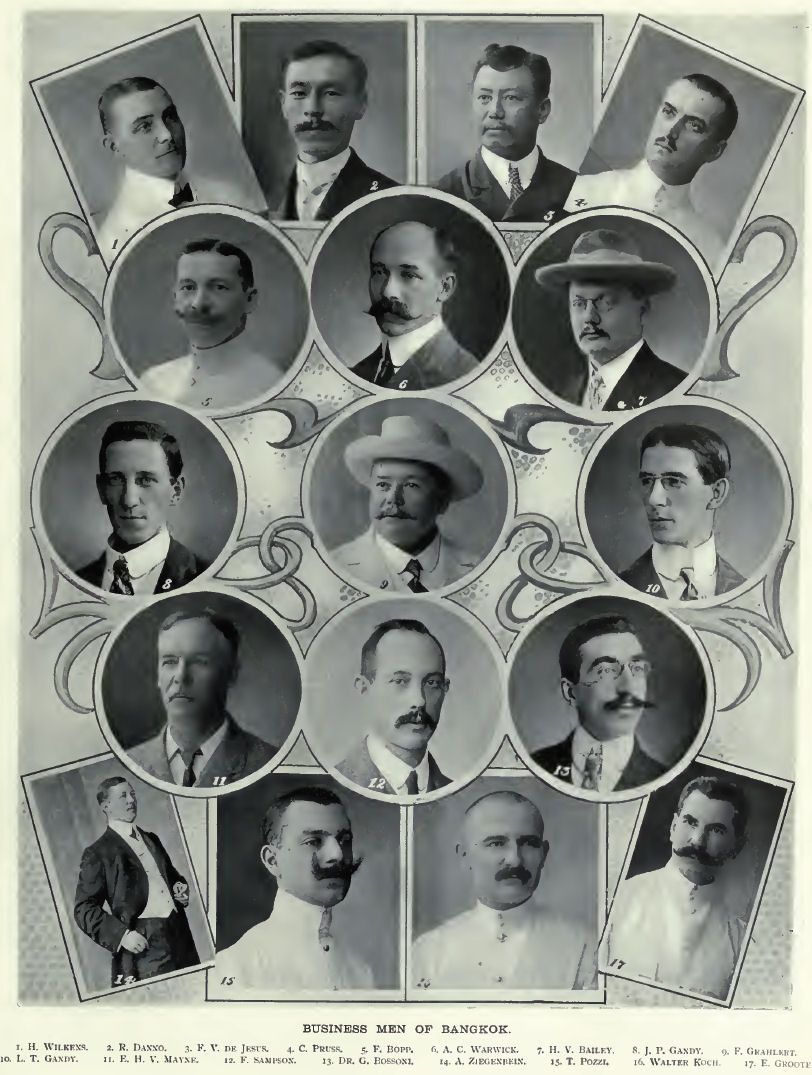
Abb.: Westliche Geschäftsleute in Bangkok
[Bildquelle: Twentieth century impressions of Siam : its history, people,
commerce, industries, and resources / ed. in chief: Arnold Wright. -- London
[etc.] : Lloyds, 1908. -- S. 265]
"A brief retrospect of the teak trade of Siam may not be out of place before proceeding to a more detailed survey of the conditions as they exist to-day. As an organised industry, initiated and developed by European capital and enterprise, it may be said to be barely half a century old. One European company had its agents in the north, buying teak logs, as far back as 1860, but apparently it was not until 1873 that any serious attempt was made to introduce Siam teak to the European market. Haslett refers to a "sample" shipment of 200 tons of teak timber from Bangkok having been brought to London in that year, and although his criticism of such sample is none too favourable, he encouragingly adds : "I am of opinion that if the timber is only carefully sorted over at Bangkok, good shipments might be made for the London market." From another authority we learn that until about the year 1881 but little more than the most tentative attempts had been made to place Siam teak on the European markets. We may take it, therefore, that as an entity of importance in the country's exports the teak trade reached its adolescence some thirty years ago. Its growth was from modest beginnings, and the legend exists that pioneer shippers, employing native hand-sawyers, "squared" their first cargo of logs in a carefully closed-up shed, so that their novel operations might be screened from the too inquisitive eyes of their neighbours. Gradually steam-sawing machinery displaced the primitive hand-sawing methods, although for many years the innumerable hand-sawing sheds owned by Chinese constituted a very considerable industry, the aggregate out-turn of which was more than equal to that of the European-owned steam mills. Up in the north agents of the principal Bangkok companies steadily developed their policy of acquiring supplies from first-hand sources, but the year 1883 marks approximately the point when European interests in the forest districts assumed solid importance, assisted by the protection afforded by the Chiengmai Treaty, signed in that year between the British and Siamese Governments, which extended the principle of extra-territoriality in a modified form to British subjects resident in Northern Siam. Not until about the year 1888, however, do we find a forest being worked by a European company ; the Siamese Government being unwilling to grant leases to European companies, who, consequently, had to obtain control of supplies of timber by advancing money to native leaseholders and contractors. The year 1896 initiated another important period for the teak trade in regard, especially, to the forest-working branch of it, as in that year the Siamese Government established a Forest Department, under British-Indian officials, whose work has been to introduce measures for the conservation of the forests. The changes introduced, including a more drastic form of lease, higher royalties, and the strict closing of various overworked areas, have not been to the immediate advantage of the trade, but it must be admitted they represent an inevitable policy on the part of any government which exercises reasonable foresight with regard to the preservation of one of its most important sources of wealth. If the trade, as represented by those companies who have sunk large sums of money in extensive sawmills and establishments on the banks of the Bangkok river, has any real ground for regret, it rather is that forest conservancy measures were not entered upon at least ten years earlier, so that future supplies of teak logs might be less of an uncertainty.
It should here be remarked that the teak trade in Siam is very largely a British interest. Out of ten or eleven steam sawmills in Bangkok five are owned by British firms, and these include the most important, while of five European companies working teak in the northern forest districts four are British. Judged by the amount of capital employed by them, the British share of the trade is even more preponderating.
The teak-bearing forests of Siam are in the northern or Laos territory, lying approximately between the sixteenth and twentieth parallels of northern latitude, having the Salween river on the west, the Mekong on the east, with the Bangkok river (the Menam) and its numerous feeders draining the centre. On the extreme west the forests drained by the tributaries of the Salween have their product worked out into that river and eventually floated down to Moulmein, hence these forests are of no direct interest to those engaged in the Bangkok trade. On the western side rich teak country exists on the Siam border, drained by the great Mekong river, but there are no water-ways communicating with the Siamese rivers, and the efforts of French traders to utilise the Mekong for floating the timber down to Saigon have not met with any considerable measure of success owing to the river being quite unsuited for the purpose. The supplies of teak for Bangkok are the product of the workings in the central portion of the Laos country, which has its water-ways liberally supplied by the Menam and its two principal tributaries, the Me Ping and Me Yome, with their branch-streams, the Me Wang and Me Nan. The principal centres of trade and population are the towns of Chiengmai, Lakon Lampang, Prae, and Nan. Chiengmai, about 500 miles' journey from Bangkok, is the oldest centre of forest operations, and it is computed that the teak forests in this district have been worked for well over half a century. Growing teak is found on the hills between the Menam Kwa Noi and the Menam Kwa Yai, north and north-west of the town of Kanburi, and this is probably the most southerly point it reaches in Indo-China ; it is not worked, however, owing to the smallness of the streams and other natural obstacles. Excellent teak forests are reported to exist in the very northerly Chiengmai district, but the absence of river communication with the south is a serious obstacle to their working. Generally speaking, the more southerly forests, which are naturally those that have been longest worked, are largely depleted of their marketable trees and, where not actually closed, are worked under severe restrictions imposed by the Conservators. The tendency is for forest operations to extend further and further northward from the old bases, and forests which, in the early days, would have been regarded as unworkable, in these times of more strenuous competition are made workable by the ingenious adaptation of mechanical appliances for the haulage of timber over hills too steep for the employment of elephants. All this makes for increased cost of extraction and delivery, and necessitates higher prices in Bangkok and from the foreign buyer for the timber. The amount of capital invested in the teak trade, both as regards the forest and sawmilling branches of it, has been variously estimated as being somewhere in the neighbourhood of £2,000,000, and although such figures are of necessity highly conjectural, it is a fact that those who engage in the business, more especially in the forestry branch, essentially require to be the possessors of very long purses. On an average some three to four years must elapse before the round teak logs can reach the Bangkok market from the time they are felled in the forest, and naturally, as working areas are operated increasingly further afield, the tendency of this average is to widen. Also, in a country where a good or bad floating season is primarily dependent on the very variable factor of rainfall, a failure of delivery has to be assured against by holding large reserves of worked out logs, which again involves a large outstanding of capital.
The various stages in the process of working the logs out of the forests will be found described elsewhere, and need not be set forth here. Assuming that the rainfall has been ample to swell the "huays," or forest streams, the logs commence to move on their long water journey to Bangkok some time about the beginning of the rainy season, May to June or July. If the water is insufficient, the elephant is called in to assist by pushing the logs over the shallower places. Once into the main streams the fast flowing current carries them down singly to the rafting and salvage stations, where the timber is collected and made up into rafts. From the various rafting stations the rafts are floated down to Paknampoh, the point at which the chief teak rivers have a common junction with the Bangkok river, the Menam, and here the inland duty is collected by the forest officials of the Siamese Government. The duty is paid according to a fixed tariff, and varies in ratio to the length and girth of each log, the average duty per log being approximately equal to 4s. at present exchange. Once this inland duty is paid there is no additional export tax levied on teak.
The following are the approximate figures of the total arrivals of teak logs at the Paknampoh Duty Station for the ten years 1898 - 1907 inclusive :—
logs
1898 50,800 1899 53,000 1900 120,000 1901 64,170 1902 64,325 1903 108,530 1904 135.140 1905 146,753 1906 86,066 1907 108,398 The average yearly delivery, according to the above figures, is 93,700 logs, but it is worthy of remark that while the average for the five years 1898-1902 was 70,459 logs, that for the five years 1903-1907 was considerably larger, viz., 116,977 logs. It is clear, in face of the sustained largeness of the arrivals for the later years, that the prophecy confidently made in 1905, that that year would mark the turning-point in the direction of a reduced volume of output, has not yet shown itself to be justified. At the same time, it must be admitted that quantity has been maintained largely at the expense of quality, many reasons having combined to make it necessary or profitable to work down a class of timber which, in former years, would have been generally regarded as too poor to repay expenditure.
Despatched from Paknampoh, after being "passed" by the duty officers, the rafts enter upon the final stage of the journey to Bangkok, and thereafter their further manipulation becomes a matter for the saw-miller. The Bangkok mills vary in size and capacity of machinery, but possess certain features in common which may be briefly described. To begin with, an ample width of river frontage is necessarily an important desideratum, as rafts of round teak require spacious storage accommodation, and the sawn logs also are moored in rafts in the water for conveyance to the exporting steamer. Next in importance to the water-frontage is the essential that there should be a "klong" (or creek) leading from the river and running up one side of the mill's premises, communicating with a "dock" into which the round logs are floated, and from which dock they are hauled up on to the mill floor by power haulage. From the mill floor power-driven overhead travelling cranes pick up the logs and place them on the steel travelling tables of the large self-acting rack benches which are in general use for the conversion of the round wood into squared logs. For the rough and ready work of slicing off the "slab" and transforming the round wood into square or rectangular-shaped timber, no type of machine has been found to equal the self-acting circular saw rack bench, with tables from 40 to 60 feet, laid flush with the mill floor, and carrying saws up to 7 feet in diameter. For the finer work of sawing the round logs into planks and similar thin material, where exact thicknessing is important, the machine in general favour is the vertical saw frame, either belt driven or with direct acting engine overhead. These two types of sawing machines constitute what is generally termed the "breaking down" mill. For resawing the slabs and small material thrown off by the big machines in the process of "breaking down," the well-equipped mill would include a full complement of circular saw benches and cross-cutting benches, while in the larger establishments various other subsidiary machinery, such as deal frames, planing machinery, shingle and key-making machinery, &c, are included.
The economical utilisation of all "waste" is of particular importance, having regard to the costly nature of the rough material, and the careful mill manager is at constant pains to develop the by-products of his mill and to diminish the firewood pile. The motive power in all cases is furnished by steam, the generation of which is quite inexpensive, as the sawdust and small refuse of the mill provide an ample supply of fuel for the furnaces. The sawing machinery of a teak mill requires to be of a very strong and solid construction to withstand the rough usage of native labour as well as the coarse and gritty character of the rough material, and it is interesting to know that practically all the Bangkok sawmills are equipped with machinery of British manufacture. Chinese, Siamese, and Burmese supply the labour, which, generally speaking, is inefficient, viewed from the European standpoint, nor has it the compensating advantage of cheapness, seeing that individual inefficiency has to be made up for by an increase in numbers.
The visitor to a Bangkok sawmill will not see anything of that perfection of ingenuity in regard to labour-saving appliances which is such an interesting feature of the large American lumber mills [...9
As may be supposed, a teak raft —which may contain anything between a hundred and two hundred logs, according to size and other circumstances—comprises many qualities of timber, the allocation of which to their proper classes for conversion in order to facilitate and expedite the work of the sawyer calls for not a little expert knowledge and practical judgment. [...]
The principal markets for Bangkok teak are Europe, India, China, Japan, Straits Settlements, Colombo, Indo-China, &c, while occasional shipments find their way to America, Africa, and Australia. Manila, which years ago was a considerable customer for Siam teak, has again become a buyer since the American occupation and subsequent development of naval construction. It is interesting to recall that Java was at one time a fairly large importer of teak from Bangkok. Nowadays, Java is keenly engaged, and not unsuccessfully, in trying to elbow Siam teak out of various markets abroad and to get its own teak preferred.
It may be assumed that practically all the best of each season's production of sawn timber is exported, while the residue, representing sizes or quality unsuit able for exportation, is consumed- locally for house-building, boat construction, and various other purposes. About four years ago the local consumption was estimated at about 15,000 to 20,000 logs per year, but it is extremely doubtful whether, in face of the great increase in cost of teak timber delivered on the Bangkok market, which has been such a marked feature of the trade in recent years, more than half this quantity is consumed at the present time. Siam is peculiarly a market which looks less at durability than at first cost, and the increasing import of cheap woods from Singapore, together with a noticeable activity in the exploitation of woods other than teak, are facts which furnish proof of the extent to which teak material is being displaced in Siam itself."
[Quelle: A. J. C. Dickson in: Twentieth century impressions of Siam : its history, people, commerce, industries, and resources / ed. in chief: Arnold Wright. -- London [etc.] : Lloyds, 1908. -- S. 171ff.]
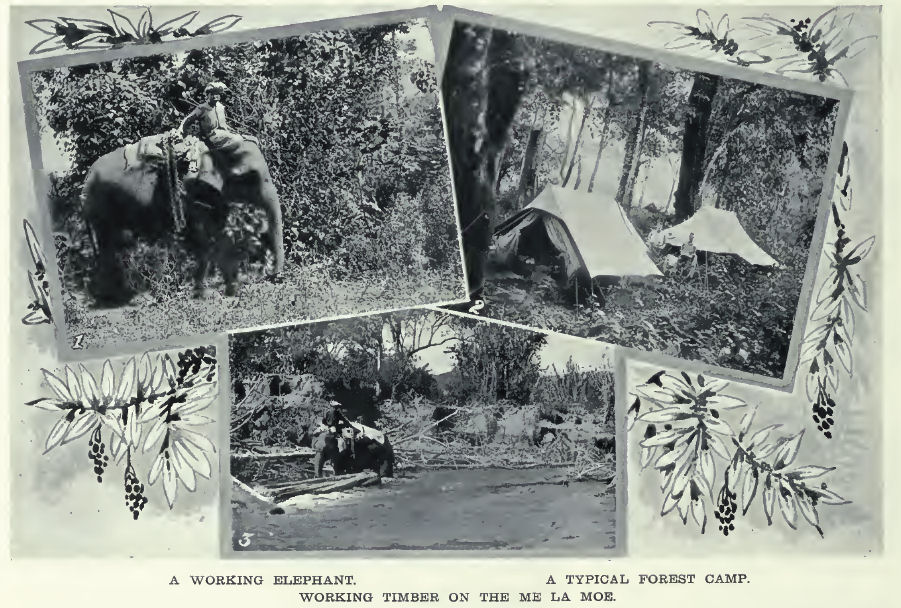
Abb.: Teak-Holz-Schlag, Mae La Moe
[Bildquelle: Twentieth century impressions of Siam : its history, people,
commerce, industries, and resources / ed. in chief: Arnold Wright. -- London
[etc.] : Lloyds, 1908. -- S. 172]
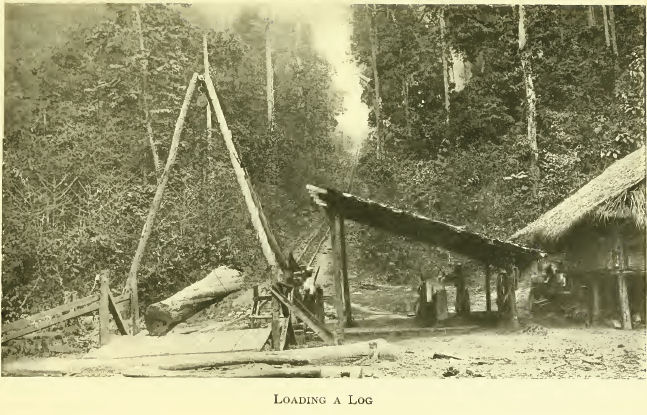
Abb.: Teakholz-Verladung
[Bildquelle:
The kingdom of Siam : Ministry of
Agriculture, Louisiana Purchase Exposition, St. Louis, U.S.A., 1904 ; Siamese
section / ed. by A. Cecil Carter. -- New York: Putnam’s Sons, 1904. -- Nach S.
174]
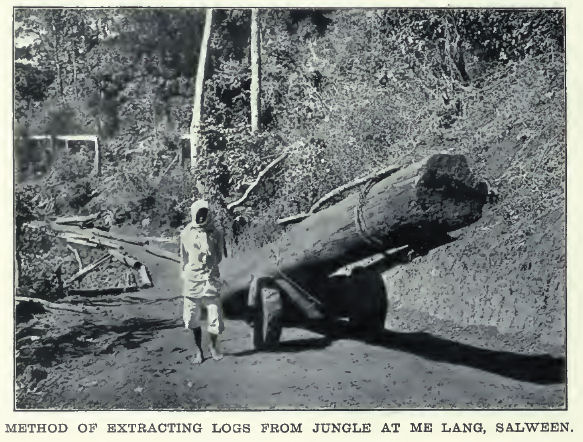
Abb.: Teakholz-Transport, Mae Lang, Salween (แม่น้ำสาละวิน)
[Bildquelle: Twentieth century impressions of Siam : its history, people,
commerce, industries, and resources / ed. in chief: Arnold Wright. -- London
[etc.] : Lloyds, 1908. -- S. 170]
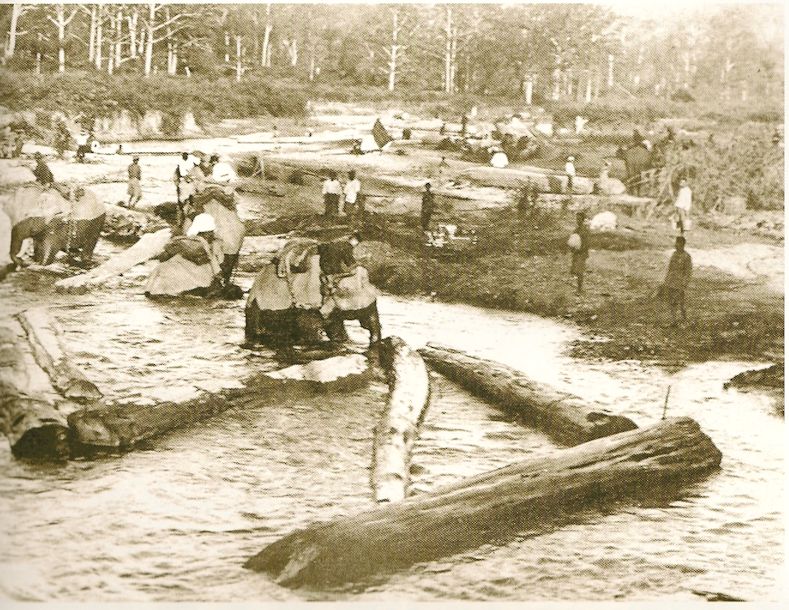
Abb.: Einsatz von Elefanten beim Flößen
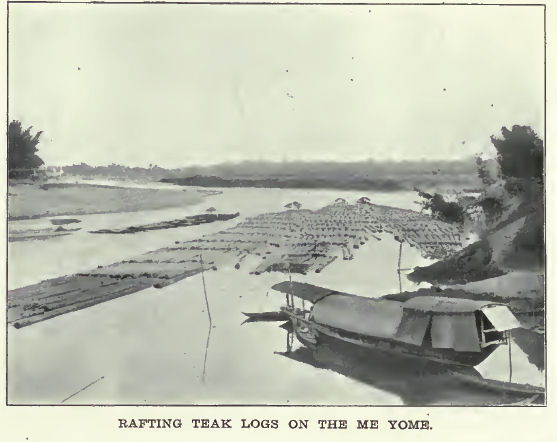
Abb.: Teakholz-Flößerei, Maenam Yom (แม่น้ำยม)
[Bildquelle: Twentieth century impressions of Siam : its history, people,
commerce, industries, and resources / ed. in chief: Arnold Wright. -- London
[etc.] : Lloyds, 1908. -- S. 173]
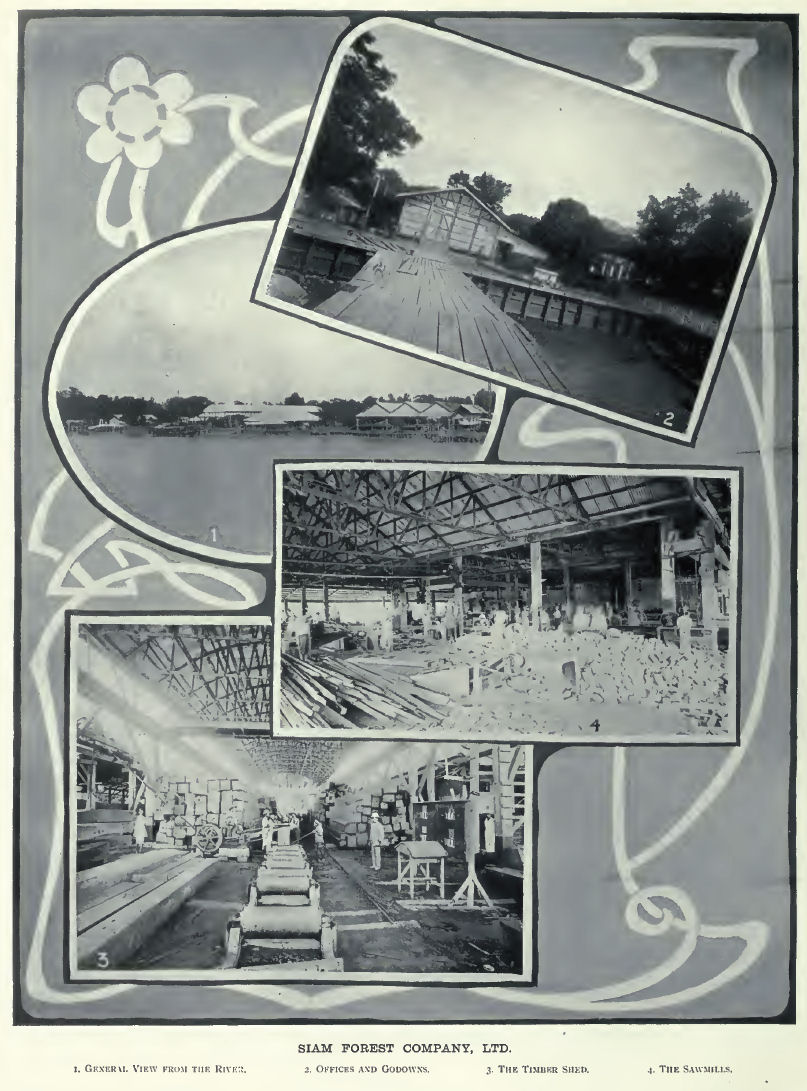
Abb.: Siam Forrest Company Ltd.
[Bildquelle: Twentieth century impressions of Siam : its history, people,
commerce, industries, and resources / ed. in chief: Arnold Wright. -- London
[etc.] : Lloyds, 1908. -- S. 176]
"SIAM FOREST COMPANY, LTD.
A general description of the teak trade, together with some details respecting the forests of Siam, appears elsewhere in this volume, and in this short sketch of the Siam Forest Company, Ltd., therefore, it is unnecessary to dwell any further upon them. The important bearing the teak industry—furnishing employment as it does for many thousands of men—has upon the prosperity of the country is well known. In this trade the Siam Forest Company, Limited, have taken a leading part for the past quarter of a century. They have immense forest concessions in Northern Siam. From these abundant supplies of teak are obtained and floated down the rivers to their sawmills, from where, after being prepared and fashioned according to requirements, it is exported to all parts of the world, but especially to India, Europe, the United Kingdom, America, and Japan. Their mills are known as the Bangkok Sawmills, and at all times they have large stocks of wood on hand. In 1899 their old mill was completely destroyed by fire. The new one, which stands on a plot of land having a water frontage of a quarter of a mile in length, has been equipped after the very latest and most improved methods, and contains the best pattern milling machinery. Recently the firm absorbed the business carried on in Bangkok under the name of Clarke & Co., of which Mr. L. Blech, the present managing director, and Mr. S. H. Hendrick, the manager in Siam for the Siam Forest Company, Ltd., were partners. They have branches in various parts of Siam—in Lakon-Lampang, Mg. Ngou, Mg. Prayou, Sawankaloke, Phrae, Ooteradit, and Paknampoh, and employ a staff of some twenty Europeans.
Apart from their interests in the timber trade, the firm conduct an extensive business as import and export merchants, importing chiefly piece goods, gunnies, coals, hardware, machinery, and exporting rice, hides, pepper, rubber, stick-lac, gamboge, gum benjamin, and other Siam products.
They are agents, too, for the Commercial Union Assurance Company, Ltd., the Guardian Assurance Company, Ltd., the Phoenix Assurance Company, Ltd., the National Bank of China, the Pacific Mail Steamship Company, the Phailin Ruby and Sapphire Mines, and the Kabin Gold Mines, &c, &c. Their head office is at No. 2, Fenchurch Avenue, London."
[Quelle: Twentieth century impressions of Siam : its history, people, commerce, industries, and resources / ed. in chief: Arnold Wright. -- London [etc.] : Lloyds, 1908. -- S. 176f.]
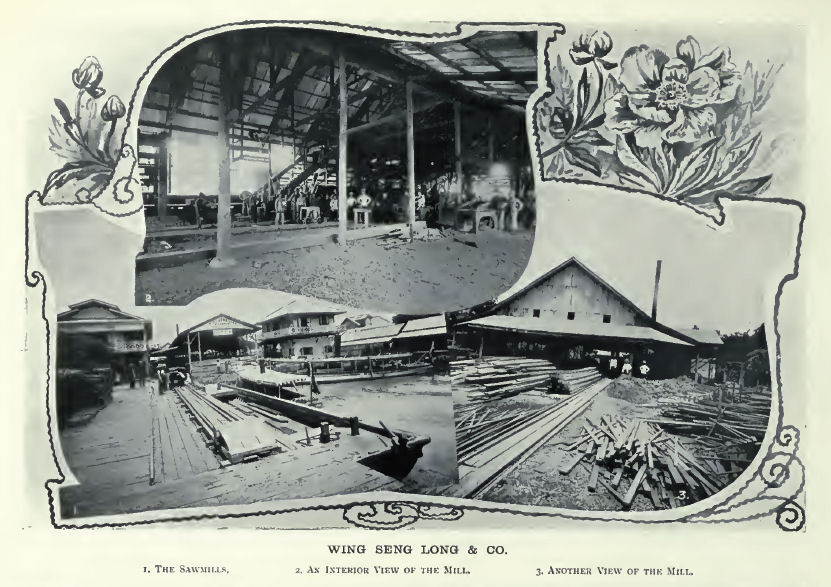
Abb.: Sägewerk Wing Seng Long & Co.
[Bildquelle: Twentieth century impressions of Siam : its history, people,
commerce, industries, and resources / ed. in chief: Arnold Wright. -- London
[etc.] : Lloyds, 1908. -- S. 180]
"WING SENG LONG & CO.
Of the many important sawmills which line the banks of the Menam river in the vicinity of Bangkok, few surpass the one owned by Messrs. Wing Seng Long & Co. It is well constructed, well equipped with modern machinery, is under the control of men who have spent their lives in the trade, and in no way falls below the standard of those mills owned by the European companies engaged in the teak industry. The plant, in the selection of which the experience of older mills in Bangkok proved an invaluable guide, consists of a large rack bench, one edging and one planking bench, three small benches, one double deal frame, a swinging cross-cut saw, two steam cross-cuts, and all the other necessary machinery for sharpening and punching saws, &c. The furnaces are of the most effective and economical type, burning sawdust as fuel.
The firm, which is a private one established only three years ago. has, up to the present, dealt with teak-wood only, and the output is mostly disposed of locally. The capital of the company consists of 250 shares of 1,000 deals each, and already a considerable reserve fund has been built up by careful management. The controlling partners are Messrs. Loh Sum, Wong Fui, and Lün Chun Beng, each of whom has charge of a different department of the business.
Messrs. Wing Seng Long & Co. are also importers of silk from Canton, in which city they have a branch under their own name. In Hongkong their branch is situated at No. 4, Queen Street, and is known as Wing Seng Chan. It is largely to these centres that their timber for export goes, although they also export to Singapore and Shanghai, and have their own agents in those ports."
[Quelle: Twentieth century impressions of Siam : its history, people, commerce, industries, and resources / ed. in chief: Arnold Wright. -- London [etc.] : Lloyds, 1908. -- S. 181]
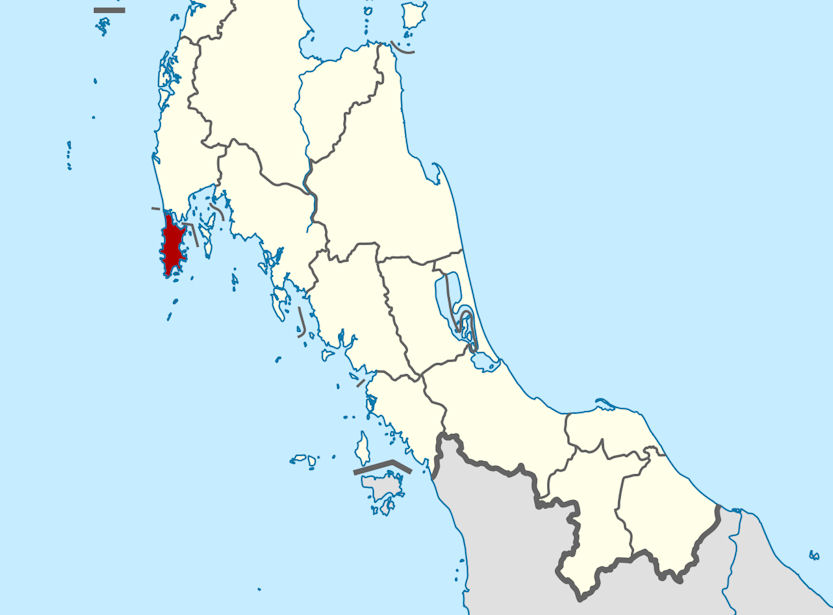
Abb.: Lage von Phuket - ภูเก็ต
[Bildquelle: NordNordWest / Wikipedia. -- GNU FDLicense]
"A study of the statistics of the world's supply of tin reveals the fact that over two-thirds of the total output comes from the Malay Peninsula and its continuation to the south in the islands of Banka and Billiton. The central portion of this long stretch of country is occupied by the States of Perak and Selangor, which produce nearly half the world's tin. The northern part consists of the Siamese State of Kedah and the province of Puket.
Tin is the only mineral which is worked on a large scale in Siam at the present time. It is disseminated more or less throughout the whole of the Siamese portions of the Malay Peninsula. Just as in the Federated Malay States to the south the west coast has produced more tin than the east, so in Siam the island of Puket and the provinces of Pangnga, Takuapa, and Renong, which face the Bay of Bengal, have proved themselves far richer than the adjacent provinces on the ether side of the peninsula. The island of Puket alone is responsible for nearly half the tin produced in the country. This island, known to the Siamese as Puket, is usually referred to as Tongkah in the Federated Malay States, and is marked as Junk Ceylon in the Admiralty charts.
There is no doubt that tin has been worked along the western shore of the Siamese portion of the peninsula for a very long time. Unfortunately, little is known of these earlier miners, and there are no statistics to show how much has been produced from these States in the past. There is little doubt, however, that before the arrival of the Chinese, who are now almost the sole workers for tin, the Indians mined along the sea coast. Evidence of this is afforded along the Pangnga shore, where old remains, such as pottery, &c, are occasionally unearthed. Along this shore there must have been a belt of rich tin-bearing land. At the present time small patches are still discovered, but on following them up they are always found to end abruptly with evident signs of the surrounding lands having been worked out in bygone times.
On the island of Puket the tin comes almost entirely from the south-east quarters. This area is bounded by ranges of high hills on the north and east, which are principally composed of slate, and are cut by granite dykes which contain the metal. The Chinese work these dykes near the surface, where they are soft and decomposed. The whole of the valley land is covered with alluvial, which in most places consists of clay to a depth of from 20 to 40 feet ; under this there is a bed of gravel containing tin varying both in thickness and in the richness of its tin contents, its average thickness in the working places being about 3 feet. This thin gravel bed must have produced tin to the value of many millions sterling. The whole of its contents appear to have come originally from the granite dykes above mentioned. The hills must have gradually weathered away, the slate producing the clay of the alluvial and the dykes the stanniferous gravel bed, the whole of the valley being then covered by the sea. The greater part of the area covered by this stanniferous bed is now worked out, though some rich patches and a good deal of the less valuable parts are left.
It has long been known that this stanniferous layer extended out into the sea at Puket Harbour. For several years the Chinese worked this submarine area by the following methods : A dam was built out from the shore so as to enclose an area of a few acres of shallow water and the sea water was then pumped out. This enclosed area was worked out, the over-burden being used to build another dam outside the first, and so enclose a second area for working. This process had been going on for a considerable time, and over 100 acres of the bay had so been worked out. The Government were then obliged to stop all further work of this kind in the harbour, as it was causing the channel to silt up so badly that at dead low water it was impossible to get to and from the town.
At this point the Government was approached on the subject of granting a concession of the whole harbour for dredging purposes, and after some negotiations a concession was given to the Tongkah Harbour Tin Dredging Company, by which they were entitled to dredge the whole harbour for tin, but must in return construct a dock and channel leading from the dock to the deep water. There is no reason to doubt that this wonderfully rich stratum, which has been proved in an unbroken line from the hills to the shore, will continue far out under the sea. The company have already one large dredge at work, and it is reported that they have ordered two more. The returns from the dredge that is working are very satisfactory under the circumstances. Naturally, on starting a new enterprise of this kind a great many unforeseen difficulties arose, but there is every indication that these difficulties have been successfully overcome, and the company should have a long and prosperous future before it.
[...]
Practically the whole of the mining on the island of Puket is carried on at the present time by Hokien Chinese. In the old days these Tongkah Chinese had the name of being the best miners in the peninsula, and undoubtedly they have shown great resource and ingenuity in their methods of work, especially in the way they have brought in water from long distances, crossing deep valleys by means of very high aqueducts constructed entirely of wood and rattan found in the vicinity, not a nail being used in their construction. At the present time their methods are in some respects behind those of the Perak Chinese, the reason of this being twofold—firstly, that they have not come so much into contact with Europeans and have not yet learnt in the same way the use of machinery ; and secondly, because the deposits are fairly uniform and shallow and there is not the same necessity for mechanical aids. So far no deep layers of tin have been discovered on the island, though frequent attempts have been made to discover them by means of boring. In this respect the Government have taken a very active part, having their own boring crews
continually at work.
In the provinces of Takuapa and Renong to the north of Puket, granite dykes occur similar in nature to those at Puket, but the conditions for laying down a large stratum of alluvial have not been so favourable. In Renong especially there is an enormous quantity of this granitic material which is decomposed down to a considerable depth, and has been worked by the Chinese for very many years. Considerable work has recently been done by an English company in (he way of prospecting this huge mass of material with the idea of hydraulising the whole hill. There were numerous difficulties in the way, however, and the company have now abandoned the idea.
[...]
Almost in the centre of the peninsula, in the State of Rahman, there are some old tin workings which have long had a great reputation among the Malays and which have been worked for a long time by the Rajah of Rahman. These old workings are on the side of a hill known as Bukit Paku, and for many years have been managed by a Chinaman of the name of Datoh Chang Wang. [...] When the Siamese Government commenced issuing regular title-deeds through the mining department, the widow of the late Rajah of Rahman was granted a lease for such land as she required in this district. In this lease the crown of the hill was not included, as the Chinese and Malays had no means of treating the alluvial at such a height, their waterways coming in at a much lower level.
At the beginning of the year 1904 applications were received from Europeans for the right to prospect in this country. Licences were duly issued, and as a result of the prospecting applications for leases were sent in and granted.
This is the origin of the two companies, the Rahman Tin Company, Ltd., and the Rahman Hydraulic Tin Company, Ltd. [...]
I have referred above to most of the important tin-mining ventures in the country. Apart from these, a great deal of work is being done in the way of prospecting, especially in Puket and the adjoining provinces, where the Siamese Tin Syndicate, Ltd., have no less than eight sets of hand-boring tools continually at work under the experienced management of Mr. H. G. Scott, whose name is in itself a guarantee of good sound work, while the Siamese Trading Corporation, Ltd., have two Keystone drillers in operation."
[Quelle: John H. Heal in: Twentieth century impressions of Siam : its history, people, commerce, industries, and resources / ed. in chief: Arnold Wright. -- London [etc.] : Lloyds, 1908. -- S. ]
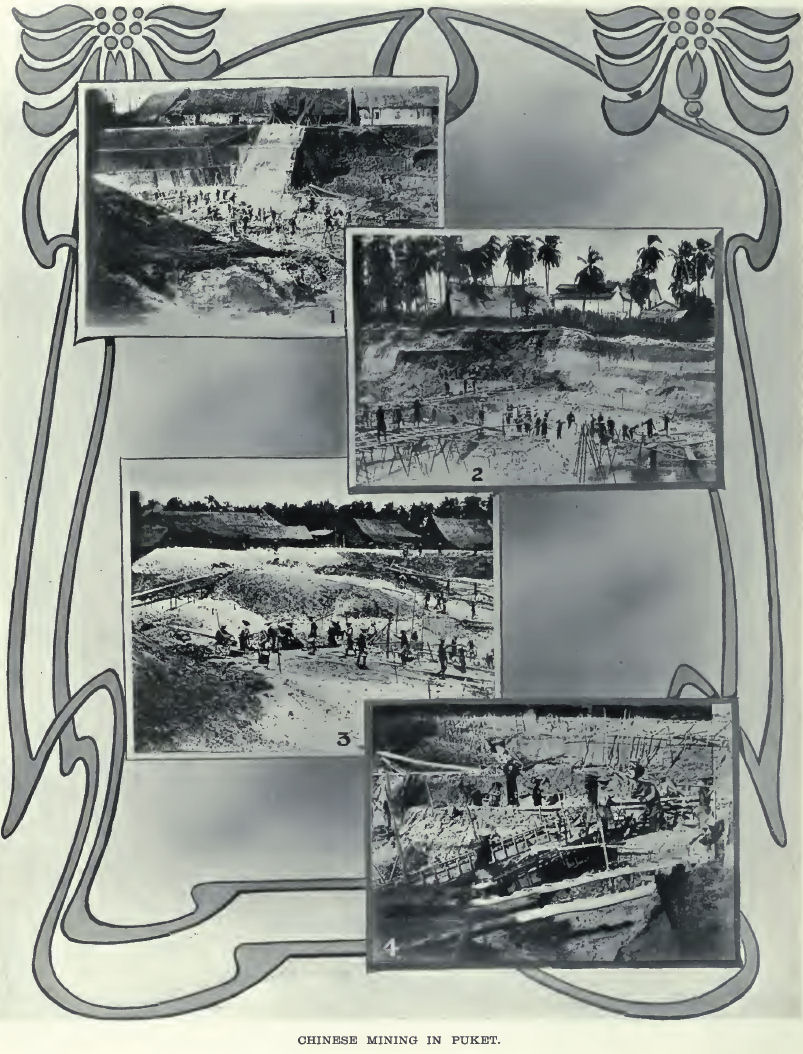
Abb.: Zinnabbau, chinesische Eigentümer, Phuket (ภูเก็ต)
[Bildquelle: Twentieth century impressions of Siam : its history, people,
commerce, industries, and resources / ed. in chief: Arnold Wright. -- London
[etc.] : Lloyds, 1908. -- S. 184]
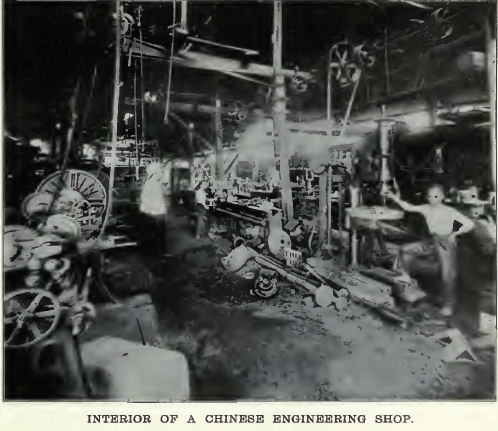
Abb.: Mechanikerwerkstatt, chinesischer Eigentümer
[Bildquelle: Twentieth century impressions of Siam : its history, people,
commerce, industries, and resources / ed. in chief: Arnold Wright. -- London
[etc.] : Lloyds, 1908. -- S. 187]
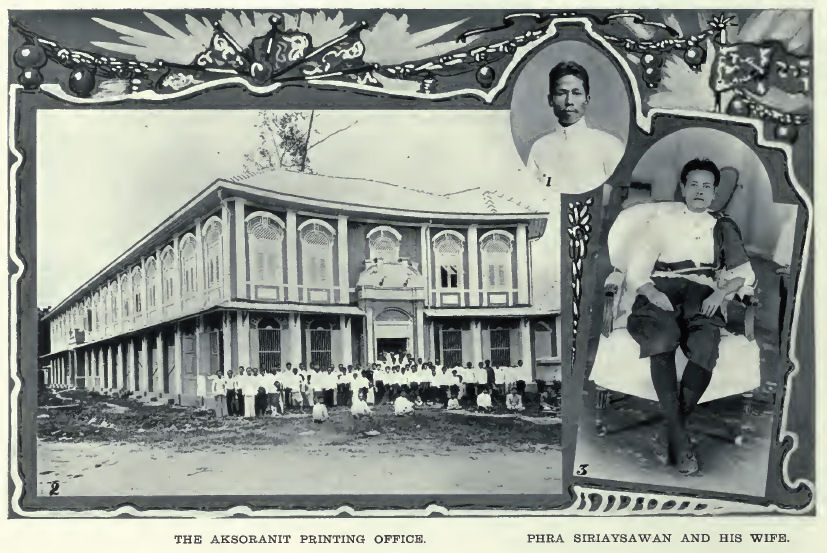
Abb.: Aksoranit-Druckerei
[Bildquelle: Twentieth century impressions of Siam : its history, people,
commerce, industries, and resources / ed. in chief: Arnold Wright. -- London
[etc.] : Lloyds, 1908. -- S. 260]
"THE AKSORANIT PRINTING OFFICE.
The Aksoranit Printing Office stands as a testimony to the steady perseverance and enterprise of Phra Siriaysawan. Phra Siriaysawan, or to give him his full titles, Phon Khun Sri Ratanart Chamun Rajaphan Tharraks Phra Siriaysawan, was born in Bangkok and educated at King's College for a period of five years. On leaving school he joined the Education Department, and afterwards the Government Printing Office, being subsequently appointed to the staff of the royal household. Following upon this came his promotion to the Ministry of Finance, and he remained in the Treasury till the year 1893, and received the added title of Phra Siriaysawan in recognition of his services. He built and started the Aksoranit Printing Office with his own capital, investing a sum of 300,000 ticals in the undertaking.
He has opened a school, attached to the office, for the teaching of those arts, such as writing, engraving, modelling, etc., a knowledge of which is calculated to raise the standard of his workmen, and with the help of his students he has invented several new processes in the printing trade, and has introduced a new type-founding machine."
[Quelle: Twentieth century impressions of Siam : its history, people, commerce, industries, and resources / ed. in chief: Arnold Wright. -- London [etc.] : Lloyds, 1908. -- S. ]
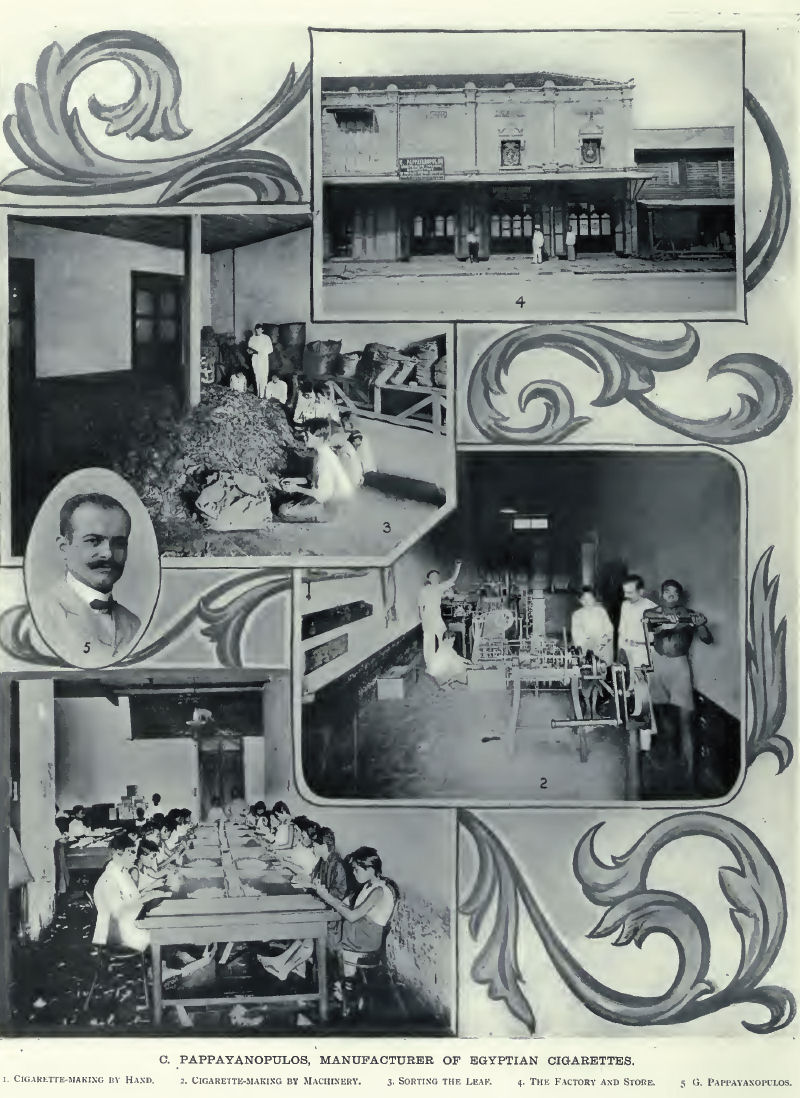
Abb.: Zigarettenfabrik C. Pappayanopulos
[Bildquelle: Twentieth century impressions of Siam : its history, people,
commerce, industries, and resources / ed. in chief: Arnold Wright. -- London
[etc.] : Lloyds, 1908. -- S. 280]
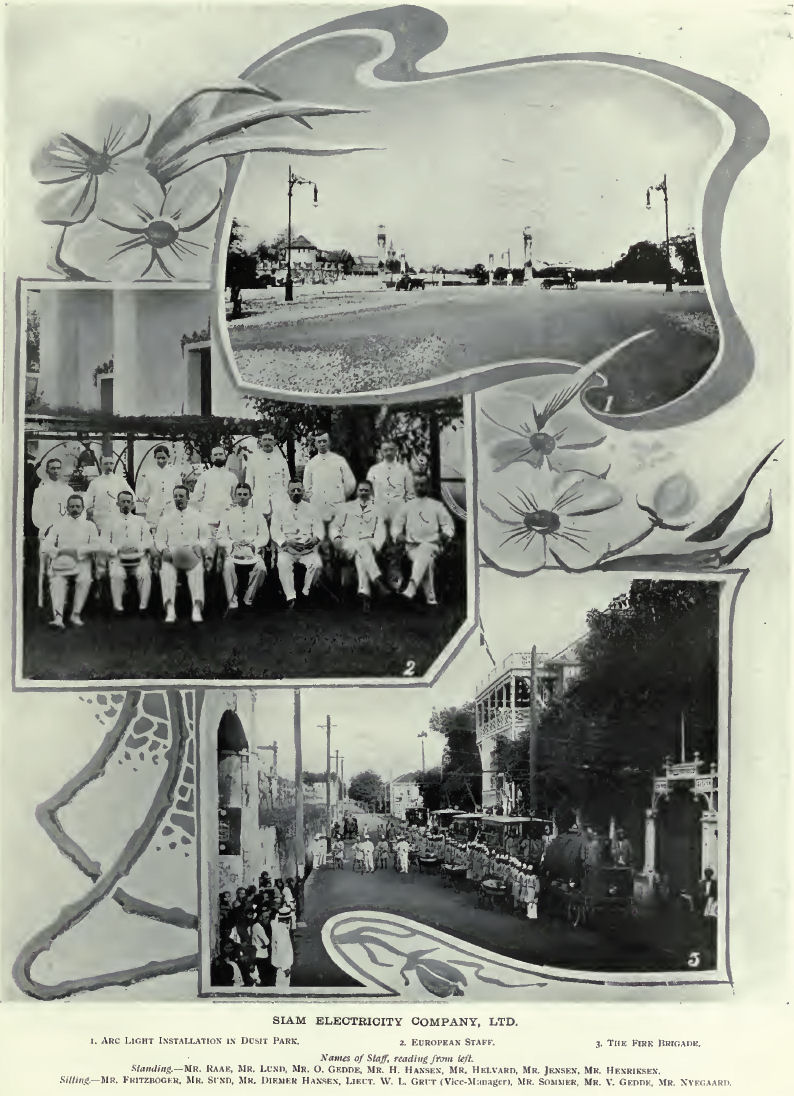
Abb.: Siam Electricity Company Ltd.
[Bildquelle: Twentieth century impressions of Siam : its history, people,
commerce, industries, and resources / ed. in chief: Arnold Wright. -- London
[etc.] : Lloyds, 1908. -- S. 189]
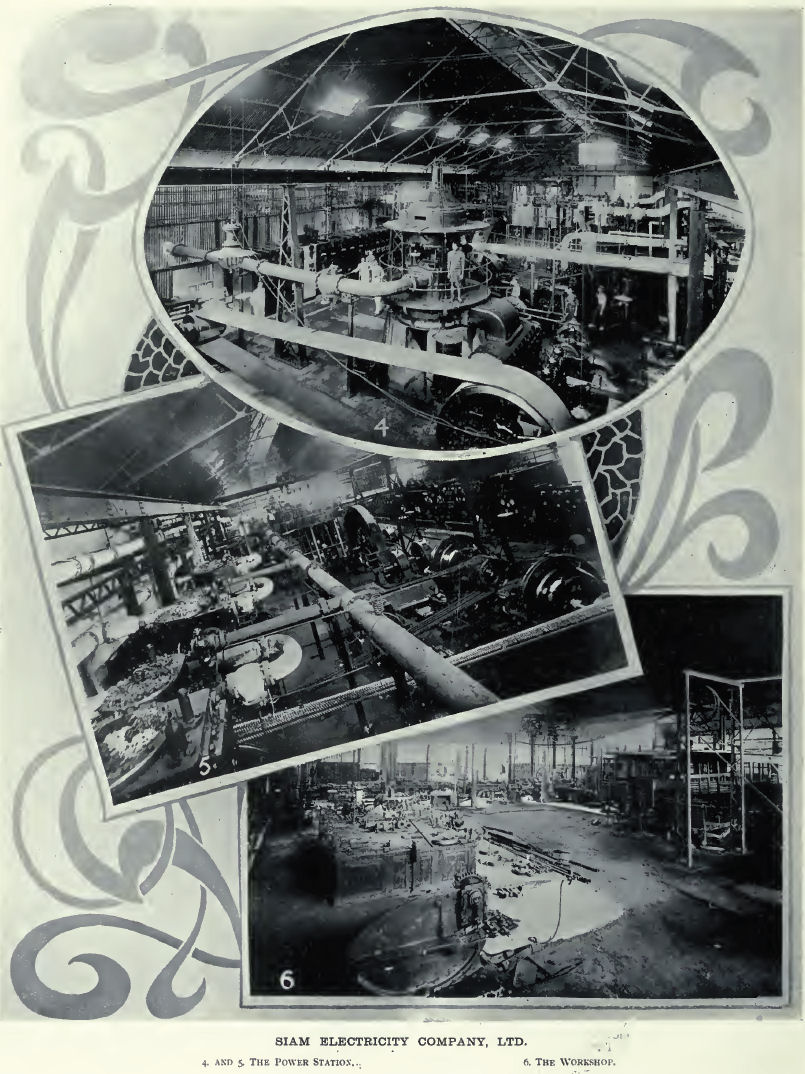
Abb.: Siam Electricity Company Ltd.
[Bildquelle: Twentieth century impressions of Siam : its history, people,
commerce, industries, and resources / ed. in chief: Arnold Wright. -- London
[etc.] : Lloyds, 1908. -- S. 190]
"THE SIAM ELECTRICITY COMPANY, LTD.
Many of those duties and responsibilities usually associated with municipal enterprise are in Bangkok undertaken by the Siam Electricity Company—a company of Danish origin, in which Danish capital is principally employed.
They contract with the Government to water certain of the streets ; they supply the whole of the city with electric light, own and operate one-half of the tramways, besides being largely interested in the Siamese Tramway Company, which controls the Dusit, Hualampong, and City Wall lines, and, in addition, are responsible for the equipment and maintenance of a fire brigade.
To trace the company's growth would be but to sketch the career of the chairman and general manager, Mr. Aage Westenholz, who on account of his energy, powers of organisation, and financial ability is entitled to a most worthy tribute. Mr. Aage Westenholz was born in Denmark in 1859, and educated at the Polytechnical High School in Copenhagen, from which institution he graduated as a civil engineer, and after a few years of European practice came to Siam in 1886. For some time he interested himself in business on his own account, and constructed a horse tramway in Bangkok, of which he was appointed manager. An electrification of the system followed, but shortly after this Mr. Westenholz severed his connection with the company he had thus far steered in safety, and once more interested himself in private civil engineering work until he took over the management of the then existing Electric Light Company, in which position he remained until the amalgamation of this company with the Tramways Company, from which stage the concern was known as the Siam Electricity Company, Ltd. In the war of 1893 against the French, Mr. Aage Westenholz enlisted as a volunteer in the Siamese Army, and was present at the battle of Paknam. Previous to his taking over the management of the Siam Electricity Company, Ltd., the concern was not in a very flourishing state. Its present-day value, however, may be gauged by the fact that its concession from the Siamese Government extends until 1950.
The first and principal branch of the company's work is that of electric lighting. By an agreement, dated November 9, 1901, the Government undertake to consume 50,000 units of current from the company in each calendar month, such supply to be entirely for the use of the Government and not for sale or transfer to private persons for the purpose of lighting or working in private houses. The power for tram-running and for lighting in streets and buildings is supplied from the central power station, situated in the middle of the distributing area."
[Quelle: C. Lamont Groundwater in: Twentieth century impressions of Siam : its history, people, commerce, industries, and resources / ed. in chief: Arnold Wright. -- London [etc.] : Lloyds, 1908. -- S. 188ff.]
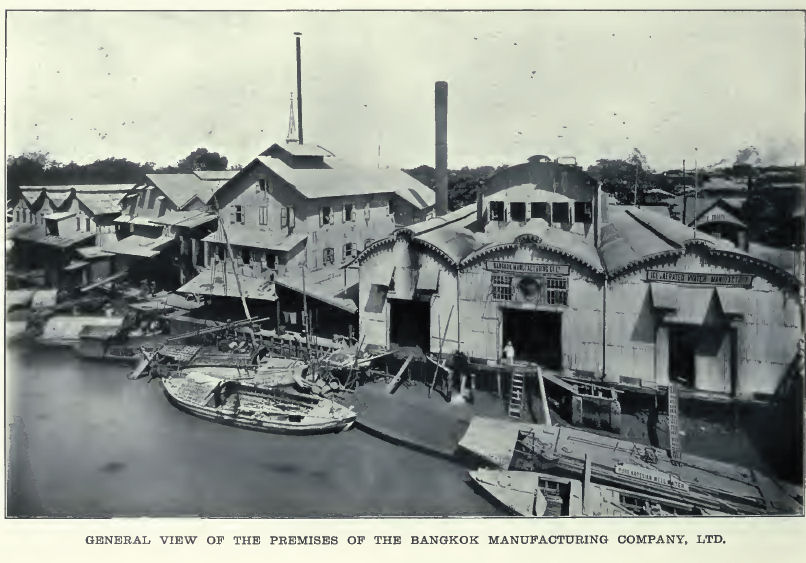
Abb.: Bangkok Manufacturing Company, Ltd.
[Bildquelle: Twentieth century impressions of Siam : its history, people,
commerce, industries, and resources / ed. in chief: Arnold Wright. -- London
[etc.] : Lloyds, 1908. -- S. 270]
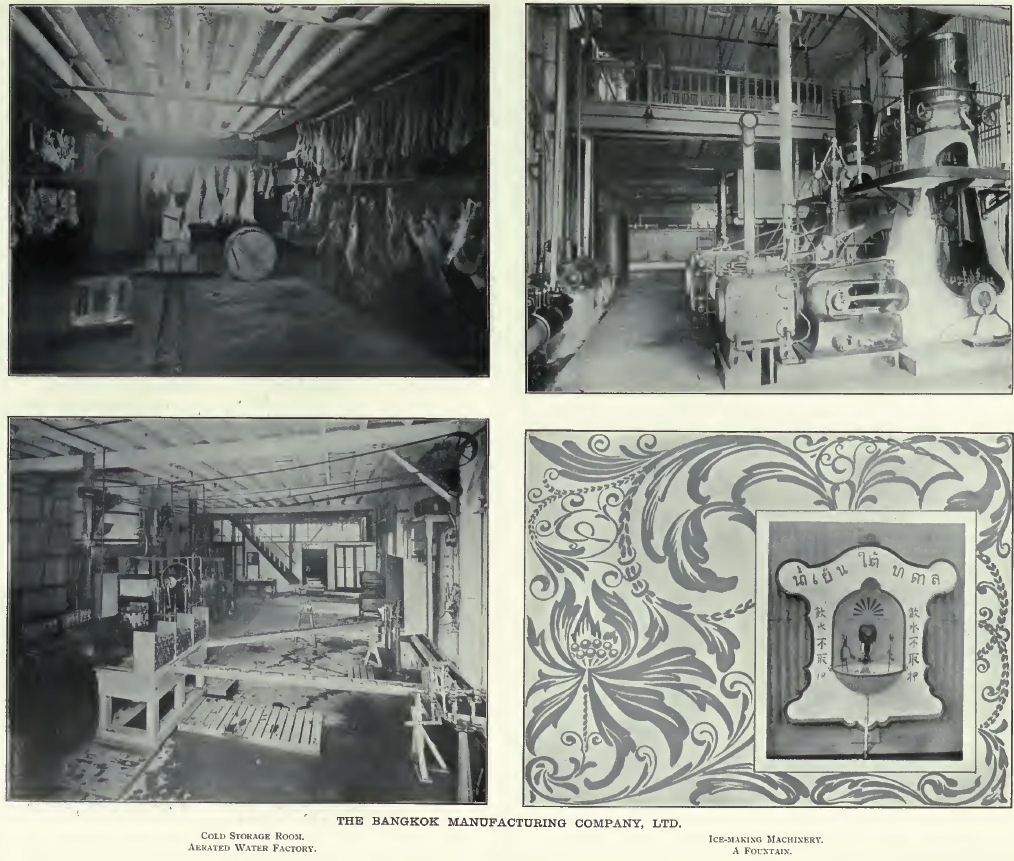
Abb.: Bangkok Manufacturing Company, Ltd.
[Bildquelle: Twentieth century impressions of Siam : its history, people,
commerce, industries, and resources / ed. in chief: Arnold Wright. -- London
[etc.] : Lloyds, 1908. -- S. 271]
"THE BANGKOK MANUFACTURING COMPANY, LTD.
The remarkable progress the Bangkok Manufacturing Company have made from the date of their establishment in 1901 shows how urgently such a commercial enterprise was needed. The important bearing a good water supply has upon the general health of a community is everywhere recognised ; Bangkok can boast of nothing of the sort, and the formation of this company, whose principal objects are the manufacture of both ice and aerated water, was consequently welcomed as a boon by all foreign residents. Starting at first with a 6-ton ice plant, the business has steadily increased until at the present time the plant consists of one 20-ton and two 6-ton ice machines, together with machinery capable of turning out 2,000 dozen bottles of aerated water a day. The ice plant, which undoubtedly is one of the finest and most complete in the East, is constructed on the ammonia principle, all the machines being supplied by the Frick Company, C.S.A. The aerated water plant by Bratby and Hinchliffe, Manchester, is of the latest design, and is fitted with all modern improvements. A constant supply of exceptionally pure and moderately hard water, so essential to the successful conduct of their undertaking, is obtained from an artesian well, some 700 feet deep, which the firm sunk on their own premises. This water, which is pumped direct from the well through no less than three large filters and finally passes through a large Berkenfeldt germ-proof filter, is used exclusively by the company for their ice and aerated waters, and as it has been repeatedly analysed by and has received the highest encomiums from the Siamese Government and Singapore Government analysts, the safety and high quality of the products are guaranteed. All the water-pipes used in the factory are of pure tin, so that contamination, it would seem, is absolutely prevented. But these are by no means the only precautions taken to guard against the possible introduction of any form of impurity, for the greatest and most scrupulous care is exercised in every detail of manufacture from first to last. The filters and pipes are regularly sterilised, and when the empty bottles are received from the consumers and the rubber rings have been removed, they also are sterilised, soaked, brushed inside and out by machinery, and finally rinsed by a powerful jet of filtered well water, for in none of the processes is anything but well water used.
Artesian well water is supplied to steamers, and is delivered in special tank wagons to the houses of residents, with whom, naturally, it is in great demand. Ice, too, is delivered twice daily to customers' houses, a convenience which is certainly not enjoyed in many Eastern towns. During 1908 the company erected a public drinking fountain in front of their headquarters. This they keep supplied with iced artesian well water, and here on a hot summer day it is estimated that upwards of 4,000 people will stop and slake their thirst. But while the manufacture of ice and aerated waters constitutes undoubtedly the chief part of the firm's business, their enterprise, as should be pointed out even in so brief a sketch of their activities as this, does not stop at this point altogether. They have excellent cold storage accommodation, and import Australian meat, fresh butter, &c, which articles, as most Bangkok residents will agree, lend a quite agreeable variety to an otherwise limited menu."
[Quelle: Twentieth century impressions of Siam : its history, people, commerce, industries, and resources / ed. in chief: Arnold Wright. -- London [etc.] : Lloyds, 1908. -- S. 270]
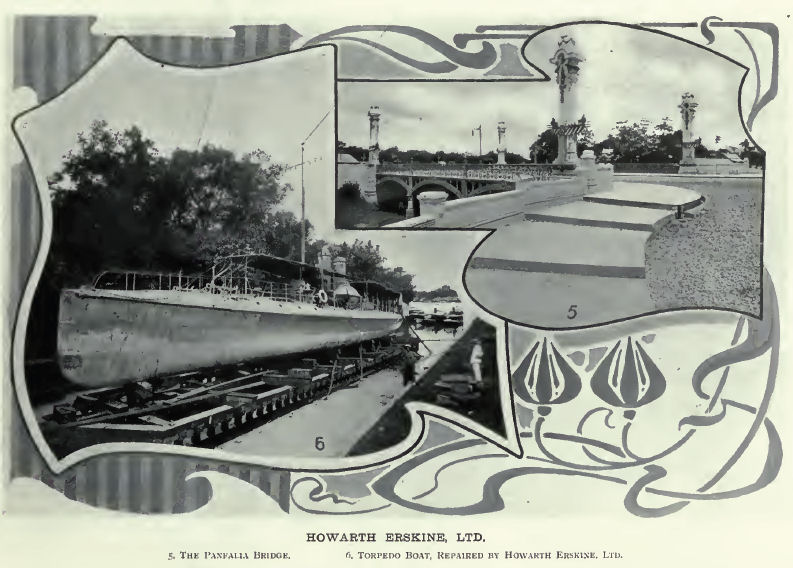
Abb.: Howarth Erskine Ltd.
[Bildquelle: Twentieth century impressions of Siam : its history, people,
commerce, industries, and resources / ed. in chief: Arnold Wright. -- London
[etc.] : Lloyds, 1908. -- S. 195]
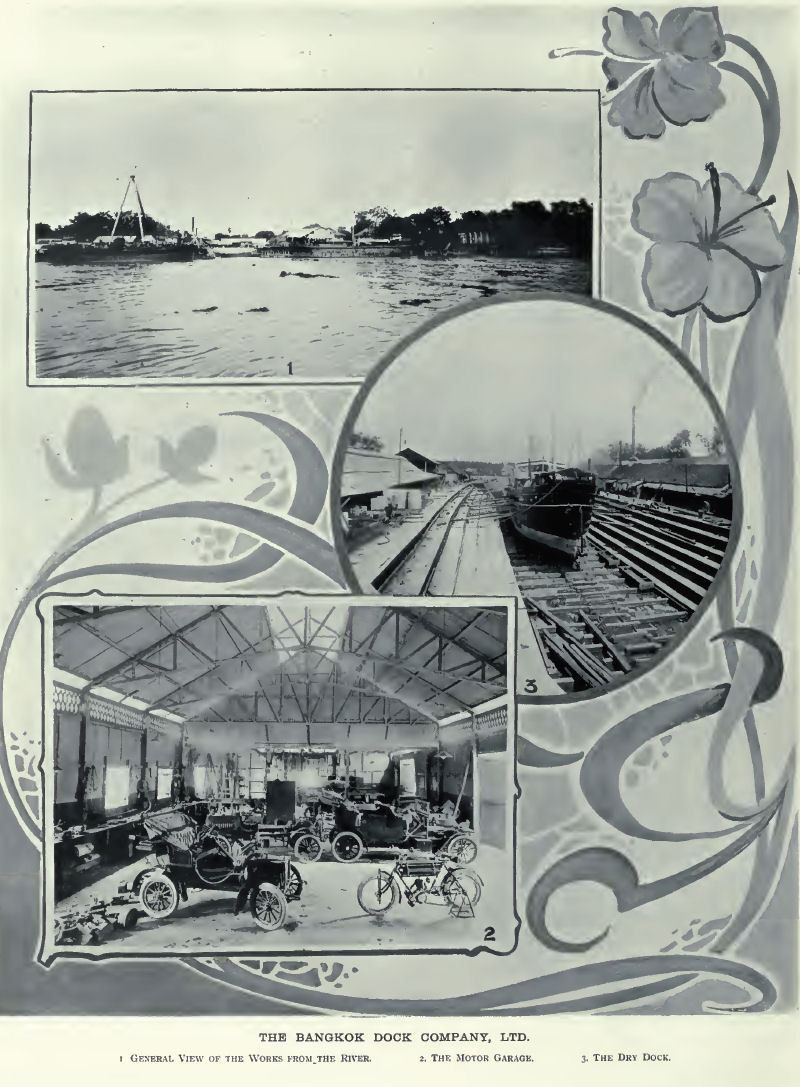
Abb.: The Bangkok Dock Company Ltd.
[Bildquelle: Twentieth century impressions of Siam : its history, people,
commerce, industries, and resources / ed. in chief: Arnold Wright. -- London
[etc.] : Lloyds, 1908. -- S. 196]
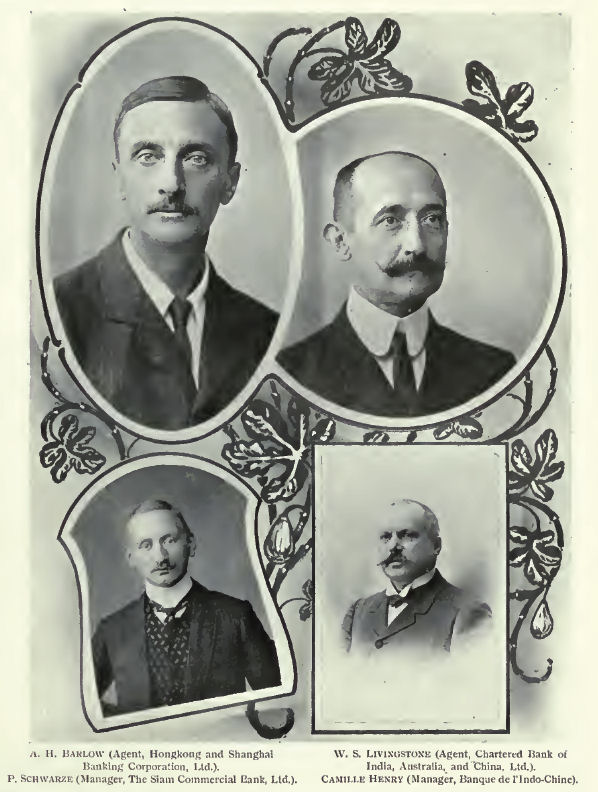
Abb.: Westliche Banker: A. H. Barlow, Hongkong and Shanghai Banking Corporation,
Ldt.; W. S. Livingstone, Chartred Bank of India, Australia, and China Ltd.; P.
Schwarze, The Siam Commercial Bank Ltd.; Camille Henry, Banque de l'Indo-Chine.
[Bildquelle: Twentieth century impressions of Siam : its history, people,
commerce, industries, and resources / ed. in chief: Arnold Wright. -- London
[etc.] : Lloyds, 1908. -- S. 117]
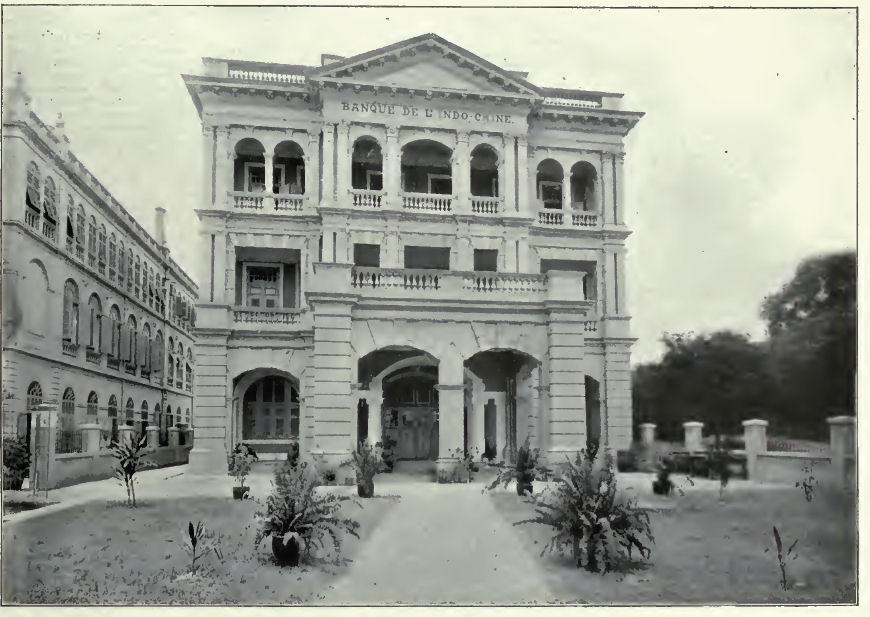
Abb.: Banque de l'Indo-Chine.
[Bildquelle: Twentieth century impressions of Siam : its history, people,
commerce, industries, and resources / ed. in chief: Arnold Wright. -- London
[etc.] : Lloyds, 1908. -- S. 119]
"The Banque de l'Indochine was a minting and banknote-issuing bank established in Paris on January 21, 1875, for the territories of France in Asia. History
Up to World War II, the bank experienced three phases of development. From 1875 to 1888, it functioned as a colonial bank to help the French government manage its colonial properties in South-east Asia. Then from 1889 to 1900, the bank shifted its operations from Indochina to China. Thereafter, from 1900 to 1941, the bank represented the interests of the French government in handling the Boxer indemnity and transacted international trade between France and China. It merged with Banque de Suez in 1974 to form Banque Indosuez, which was then purchased by the Crédit Agricole group, which operated it as Crédit Agricole Indosuez (CAI), until a 2004 merger with Crédit Lyonnais, which created Calyon."
[Quelle: http://en.wikipedia.org/wiki/Banque_de_l%27Indochine. -- Zugriff am 2011-10-17]
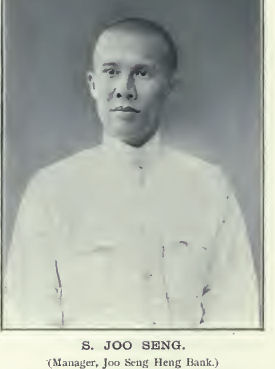
Abb.: S. Joo Seng, Joo Seng Heng Bank
[Bildquelle: Twentieth century impressions of Siam : its history, people,
commerce, industries, and resources / ed. in chief: Arnold Wright. -- London
[etc.] : Lloyds, 1908. -- S. 118]
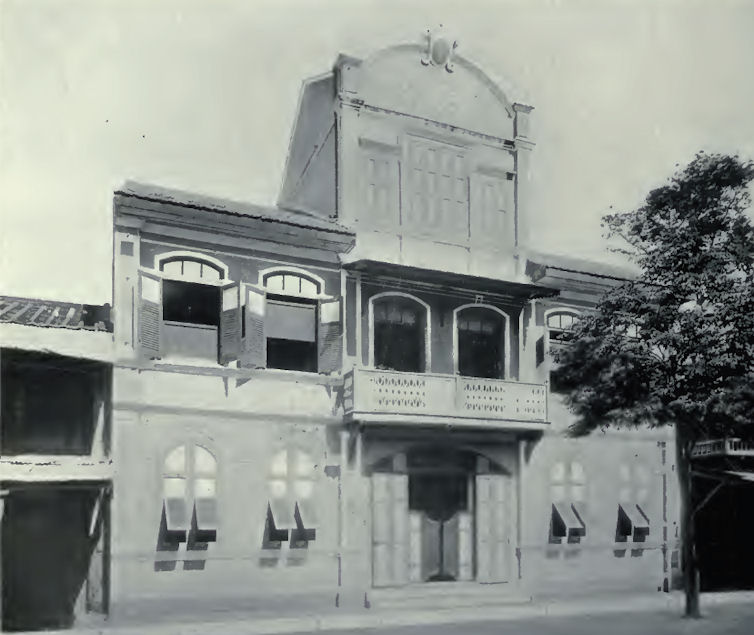
Abb.: Joo Seng Heng Bank
[Bildquelle: Twentieth century impressions of Siam : its history, people,
commerce, industries, and resources / ed. in chief: Arnold Wright. -- London
[etc.] : Lloyds, 1908. -- S. 118]
"Up to the present day the rivers form the principal means of communication in the country. In the wet season they are navigable for many miles northward, but in the dry season they are navigable only in the plains.
Canals.
In addition to the rivers a regular network of canals serve not only for communication purposes, but also contribute largely to the rapid spread of the inundation of the country during flood-time, while when the waters in the rivers go down they act as drainage channels. The canals are of comparatively recent date. It is probable that none of them were in existence a century ago. The principal canals are those in the southern part of the lower Menam plain, which connect the Menam Chow Phya with the Bangpakong river to the east, and with the Supan river and the Meklong to the west.
In some cases these canals are straight channels, immediately connecting one river with the other. But more often the canals are a continuation of existing natural channels which were running more or less in the direction desired. All the old canals were dug by corvée labour, partly under the direct orders of the Government, partly by their powerful nobles through their numerous retainers. A recent enterprise, however, on a very grand scale and shaped on modern lines, having for its object the development of the country by a system of canals, may be separately mentioned.
In 1889 the Government granted a concession, for a period of twenty-five years, for digging canals in the jungles between the Menam Chow Phya and the Nakorn Nayok river, to the north of the canal San Sep, to a private company, the Siam Canals Land and Irrigation Company, under stipulation that all the uncultivated lands of the region crossed by the canals to be excavated, to a certain distance at both sides thereof, should belong to the company. The company has constructed by machinery a system of navigation and inundation canals, to a total length of about 500 miles, embracing an area of land of about 400,000 acres. The main canal, Klong Rangsit, connects the Menam Chow Phya with the Nakorn Nayok river, and is at both ends closed by locks, which retain the water in the territory of the company. Since 1895 nearly the whole of this area of 400,000 acres, which was formerly uncultivated jungle, has gradually been converted into valuable paddy-lands, which, with regard to inundation possibilities, are better placed than most other parts of lower Siam.
One of the most notable reforms carried through by his present Majesty has been the abolition of corvée labour ; but while such a measure was most urgently desired, there can be no doubt regarding the detrimental influence it had, in the first instance, upon the upkeep of the canals. They had been hitherto constructed and maintained by corvée labour, and when this was no longer obtainable they quickly fell into disrepair. This circumstance and the heavy losses of crop which repeatedly occurred in the fairly frequent years of scanty rainfall, however, have now led the Government seriously to take the upkeep of the canals in hand, and have caused them also, at the same time, to establish an irrigation service for the purpose of drawing up an irrigation and drainage scheme for the lower Menam plain. The scheme, works for which were started in 1904, purports to dredge out the canals concerned to a depth of five feet below low-water level, and to build a certain number of navigation locks in order to be able to retain the water in the canals at a certain desired level.
In the Gulf of Siam there is a difference between ebb and flood level of about six feet. In the dry season this difference affects the rivers up to about sixty miles, measured in a straight line from the coast, and as the rivers, so also are the canals affected. Most of the canals serve to inter-connect the main rivers, and in consequence at high tide the water enters these canals at both ends where they join the tidal rivers. The two currents meet in the middle part of the canal, and as the water is nearly stagnant, the silt which it carries is deposited here. Consequently the middle parts silt up quickly and run dry at low tide. The navigation locks are intended to keep the level at a certain desired height, so that boat traffic can continue without interruption at any time of the day. They will also serve to prevent the tidal currents in the canals and to keep the brackish water out as far as fresh water is obtainable.
In connection with this improvement scheme twelve navigation locks and six inlet and outlet sluices have been constructed, and other works are to be taken up. The expenses of the upkeep and management of these works are covered by the collection of lock fees."
[Quelle: J. Homan van der Heide in: Twentieth century impressions of Siam : its history, people, commerce, industries, and resources / ed. in chief: Arnold Wright. -- London [etc.] : Lloyds, 1908. -- S. 200f.]
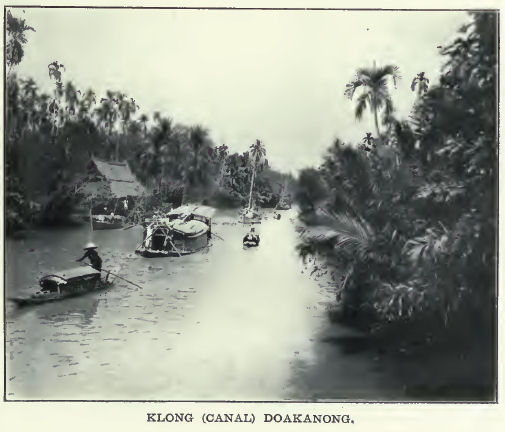
Abb.: Klong (คลอง)
[Bildquelle: Twentieth century impressions of Siam : its history, people,
commerce, industries, and resources / ed. in chief: Arnold Wright. -- London
[etc.] : Lloyds, 1908. -- S. 199]
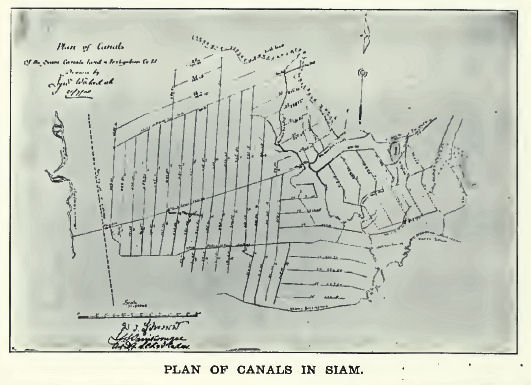
Abb.: Plan von Kanälen
[Bildquelle: Twentieth century impressions of Siam : its history, people,
commerce, industries, and resources / ed. in chief: Arnold Wright. -- London
[etc.] : Lloyds, 1908. -- S. 202]
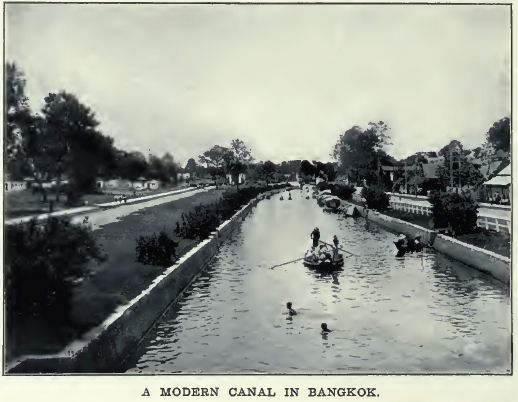
Abb.: Moderner Klong (คลอง) in Bangkok
[Bildquelle: Twentieth century impressions of Siam : its history, people,
commerce, industries, and resources / ed. in chief: Arnold Wright. -- London
[etc.] : Lloyds, 1908. -- S. 200]
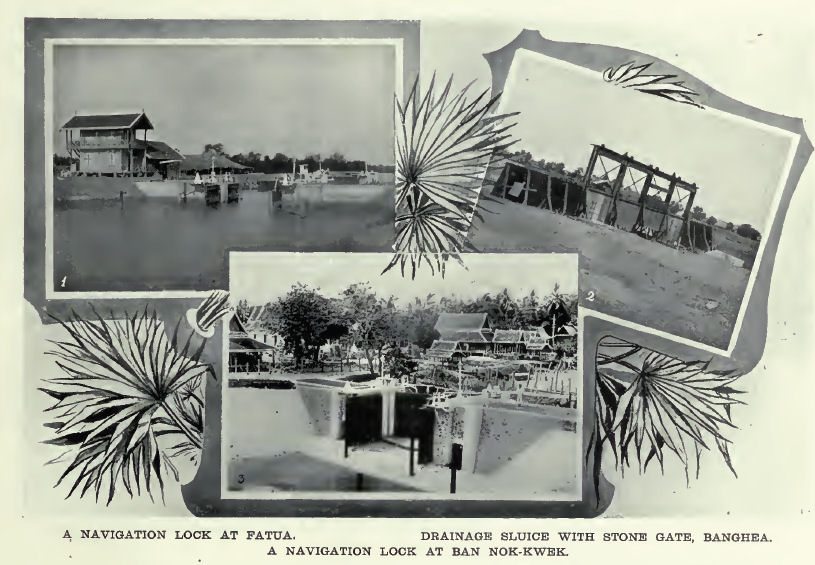
Abb.: Wasserbauten
[Bildquelle: Twentieth century impressions of Siam : its history, people,
commerce, industries, and resources / ed. in chief: Arnold Wright. -- London
[etc.] : Lloyds, 1908. -- S. 201]
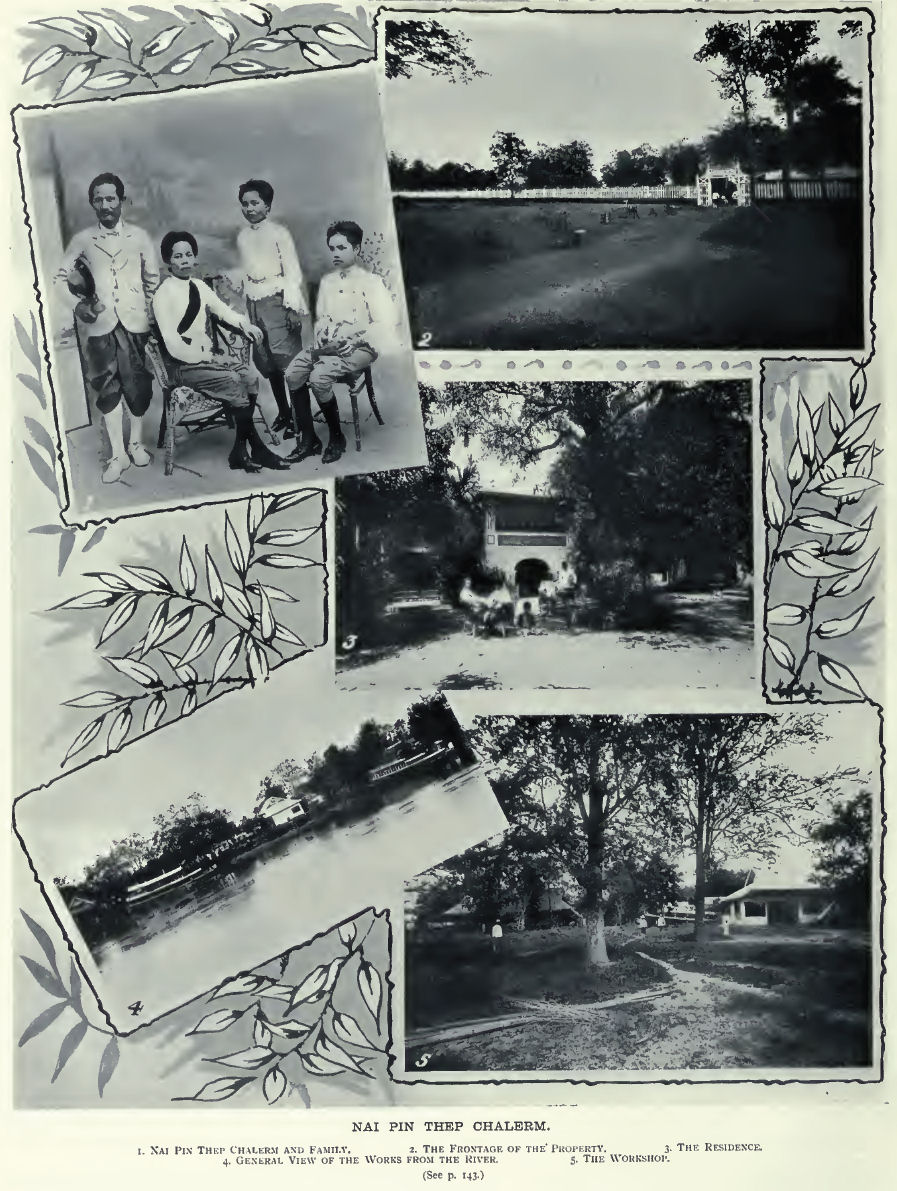
Abb.: Nai Pin Thep Chalerm
[Bildquelle: Twentieth century impressions of Siam : its history, people,
commerce, industries, and resources / ed. in chief: Arnold Wright. -- London
[etc.] : Lloyds, 1908. -- S. 138]
"SUPHAN STEAM PACKET COMPANY.
The boats of the Suphan Steam Packet Company ply between Suphan and Tachin, calling at Nakorn Chaisri on the way and connecting with the different train services of Petchaburi, Tachin, and Meklong. At first this company possessed only two boats, Khoon Chang and Nang Pim. When, however, owing to good management they became more prosperous, additional boats were built, namely, the Khoon Paan, Phra Wai Worauart, Luang Tang Chai, and two motor boats, Gumar Tong and Nang Simila. Others, too, are in course of construction. The company possess docks and sheds containing the necessary machinery and implements for the execution of repairs.
Nai Pin Thep Chalerm, the director of the company, and formerly the owner of the steamboats Sunbeam and Sundawn, which used to ply between Bangkok and Prachim, is the son of the late Phya Sri Sararaj Pakdi Sismuha and grandson of Somdet Chao Phya Borom Maha Pra Yura Wongse. He is married to Somboon, has two daughters, the elder of whom is married to Mom Chao Traidos Prabandh, son of H.R.H. Prince Devawongse Varoprakar. Nai Pin Thep Chalerm is a member of the Order of Chula Chom Klao (third class), which means that he is the recognised heir of the Sri Sararaj family."
[Quelle: Twentieth century impressions of Siam : its history, people, commerce, industries, and resources / ed. in chief: Arnold Wright. -- London [etc.] : Lloyds, 1908. -- S. 143]
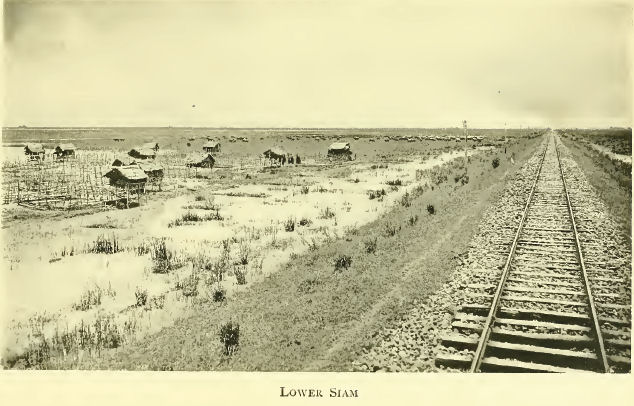
Abb.: Eisenbahnlinie in Zentralsiam
[Bildquelle:
The kingdom of Siam : Ministry of
Agriculture, Louisiana Purchase Exposition, St. Louis, U.S.A., 1904 ; Siamese
section / ed. by A. Cecil Carter. -- New York: Putnam’s Sons, 1904. -- Nach S.
36]
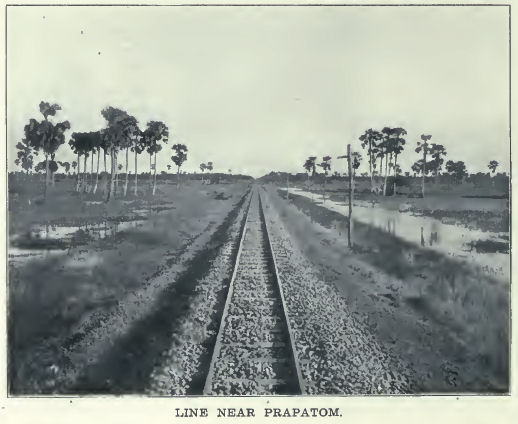
Abb.: Eisenbahnlinie bei Nakhon Pathom -
นครปฐม
[Bildquelle: Twentieth century impressions of Siam : its history, people,
commerce, industries, and resources / ed. in chief: Arnold Wright. -- London
[etc.] : Lloyds, 1908. -- S. 202]
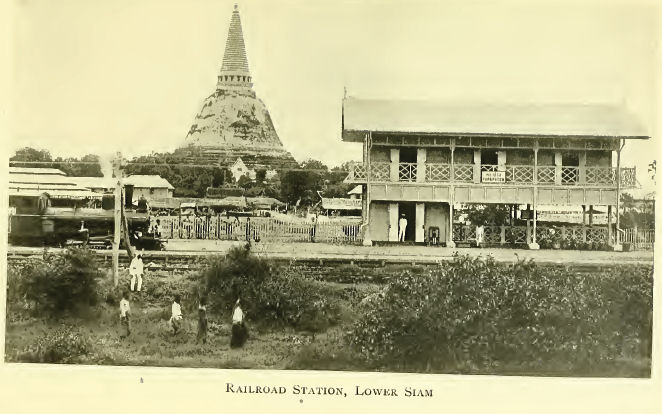
Abb.: Bahnstation Nakhon Pathom -
นครปฐม
[Bildquelle:
The kingdom of Siam : Ministry of
Agriculture, Louisiana Purchase Exposition, St. Louis, U.S.A., 1904 ; Siamese
section / ed. by A. Cecil Carter. -- New York: Putnam’s Sons, 1904. -- Nach S.
40]
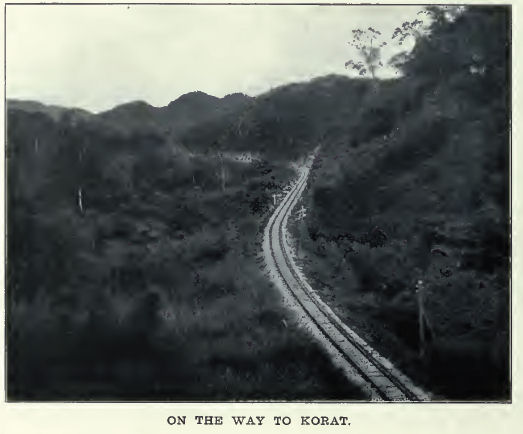
Abb.: Auf der Strecke nach Korat -
โคราช
[Bildquelle: Twentieth century impressions of Siam : its history, people,
commerce, industries, and resources / ed. in chief: Arnold Wright. -- London
[etc.] : Lloyds, 1908. -- S. 204.]
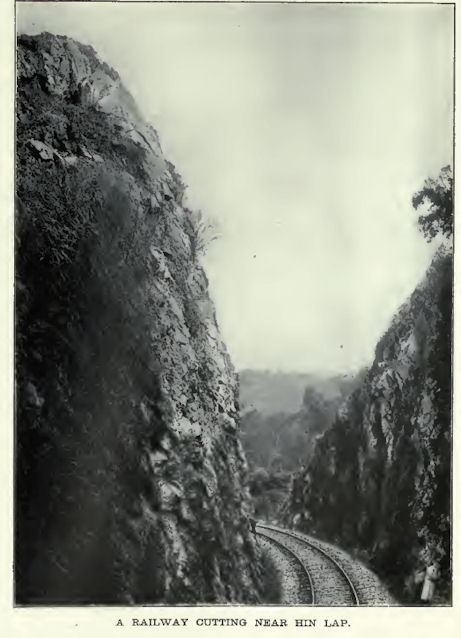
Abb.: Eisenbahn bei Ban Hin Lap (Strecke nach Korat -
โคราช)
[Bildquelle: Twentieth century impressions of Siam : its history, people,
commerce, industries, and resources / ed. in chief: Arnold Wright. -- London
[etc.] : Lloyds, 1908. -- S. 205]
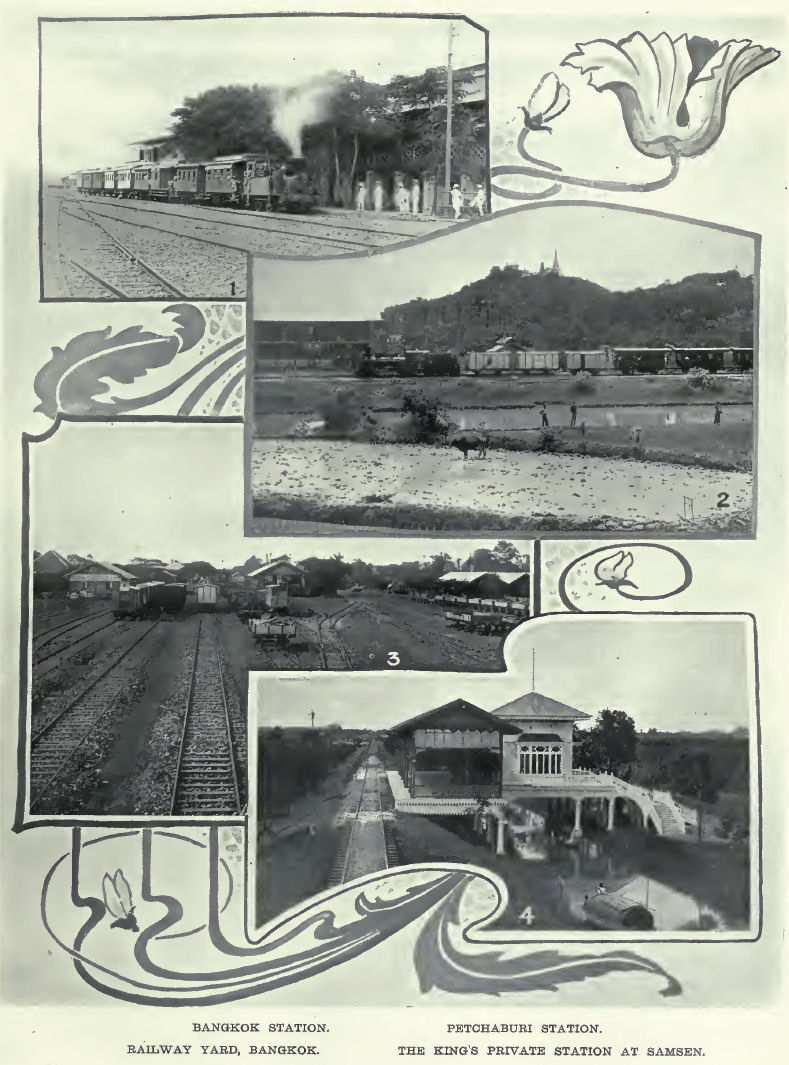
Abb.: Eisenbahnwesen
[Bildquelle: Twentieth century impressions of Siam : its history, people,
commerce, industries, and resources / ed. in chief: Arnold Wright. -- London
[etc.] : Lloyds, 1908. -- S. 203.]